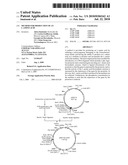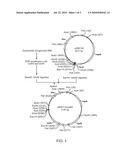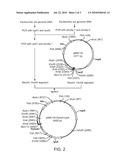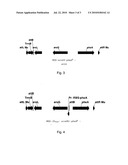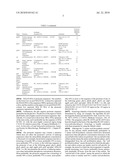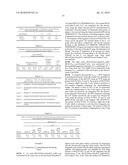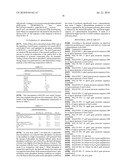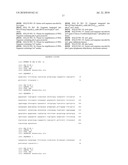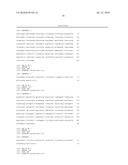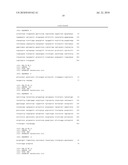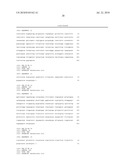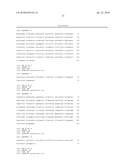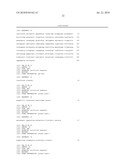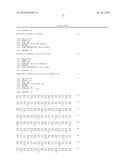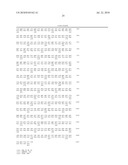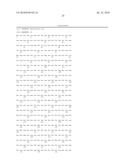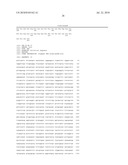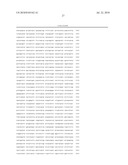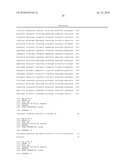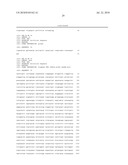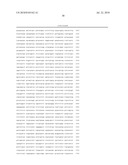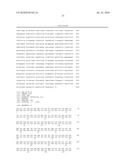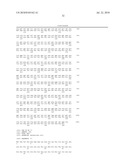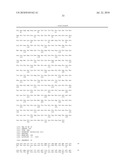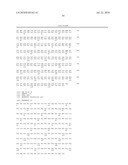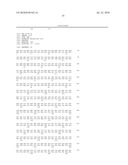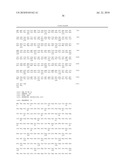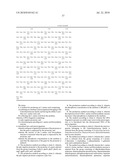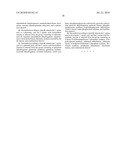Patent application title: METHOD FOR PRODUCTION OF AN L-AMINO ACID
Inventors:
Akira Imaizumi (Kawasaki-Shi, JP)
Larisa Gotlibovna Airikh (Moscow Region, RU)
Vera Georgievna Doroshenko (Moscow, RU)
Irina Sergeevna Tsyrenzhapova (Moscow, RU)
IPC8 Class: AC12P1304FI
USPC Class:
435108
Class name: Micro-organism, tissue cell culture or enzyme using process to synthesize a desired chemical compound or composition preparing alpha or beta amino acid or substituted amino acid or salts thereof tryptophan; tyrosine; phenylalanine; 3,4 dihydroxyphenylalanine
Publication date: 2010-07-22
Patent application number: 20100184162
Claims:
1. A method for producing an L-amino acid comprising:A) culturing in a
medium a microorganism belonging to the Enterobacteriaceae family and
having the ability to produce an L-amino acid, andB) collecting the
L-amino acid from the medium,wherein a DNA fragment comprising:i) a pho
regulon promoter, andii) a structural gene encoding an L-amino acid
biosynthetic enzymeis introduced into said microorganism,wherein said
gene is ligated downstream of the promoter so that the gene is expressed
by the promoter, andwherein the activity of the L-amino acid biosynthetic
enzyme is increased when the gene is expressed by the promoter,
andwherein the phosphorus concentration in the medium is such that the
expression of the gene by the promoter is induced.
2. The production method according to claim 1, wherein the pho regulon promoter is the promoter of a gene selected from the group consisting of phoA, phoB, phoE, phoH, asr, argP, ugpB, pstS, psiE, and phnC.
3. The production method according to claim 1, wherein the pho regulon promoter comprises a pho box.
4. The production method according to claim 1, wherein the phosphorus concentration in the medium is 200 μM/L or lower.
5. The production method according to claim 1, wherein the expression level of the L-amino acid biosynthetic enzyme decreases when phosphorus is depleted in the medium.
6. The method according to claim 1, wherein the DNA fragment is present on a multi-copy vector in the microorganism, or is introduced into the chromosomal DNA of the microorganism.
7. The method according to claim 1, wherein the microorganism belonging to the Enterobacteriaceae family is selected from the group consisting of Escherichia bacteria, Enterobacter bacteria, Pantoea bacteria, Klebsiella bacteria, and Serratia bacteria.
8. The method according to claim 1, wherein the L-amino acid is selected from the group consisting of L-lysine, L-threonine, L-tryptophan, L-phenylalanine, L-glutamic acid, and combinations thereof.
9. The method according to claim 8, wherein the L-amino acid is L-lysine, and the L-amino acid biosynthetic enzyme is selected from the group consisting of dihydrodipicolinate reductase, diaminopimelate decarboxylase, diaminopimelate dehydrogenase, phosphoenolpyruvate carboxylase, aspartate aminotransferase, diaminopimelate epimerase, aspartate semialdehyde dehydrogenase, tetrahydrodipicolinate succinylase, succinyl diaminopimelate deacylase, and combinations thereof.
10. The method according to claim 8, wherein the L-amino acid is L-threonine, and the L-amino acid biosynthetic enzyme is selected from the group consisting of aspartokinase III, aspartate semialdehyde dehydrogenase, aspartokinase I, homoserine kinase, threonine synthase encoded by the thr operon, and combinations thereof.
11. The method according to claim 8, wherein the L-amino acid is L-glutamic acid, and the L-amino acid biosynthetic enzyme is selected from the group consisting of glutamate dehydrogenase, glutamine synthetase, glutamate synthase, isocitrate dehydrogenase, aconitate hydratase, citrate synthase, phosphoenolpyruvate carboxylase, pyruvate carboxylase, pyruvate dehydrogenase, pyruvate kinase, phosphoenolpyruvate synthase, 6-phosphogluconate dehydratase, 2-keto-3-deoxy-6-phosphogluconate aldolase, and combinations thereof.
12. The method according to claim 8, wherein the L-amino acid is an aromatic L-amino acid, and the L-amino acid biosynthetic enzyme is selected from the group consisting of 3-deoxy-D-arabinoheptulonate-7-phosphate synthase, 3-dehydroquinate synthase, shikimate dehydratase, shikimate kinase, 5-enolpyruvylshikimate 3-phosphate synthase, chorismate synthase, prephenate dehydratase, chorismate mutase, and combinations thereof.
Description:
[0001]This application is a continuation under 35 U.S.C. §120 to PCT
Patent Application No. PCT/JP2007/051815, filed on Feb. 2, 2007, which
claims priority under 35 U.S.C. §119 to Japanese Patent Application
No. 2006-025620, filed Feb. 2, 2006, both of which are incorporated by
reference. The Sequence Listing in electronic format filed herewith is
also hereby incorporated by reference in its entirety (File Name:
US-369_Seq_List_Copy--1; File Size: 54 KB; Date Created: Aug. 1,
2008).
BACKGROUND OF THE INVENTION
[0002]1. Technical Field
[0003]The present invention relates to a method for producing an L-amino acid using a microorganism, especially L-lysine, L-threonine, L-phenylalanine, and L-tryptophan. These are industrially useful L-amino acids, for example, L-lysine, L-threonine, and L-tryptophan are useful as additives in animal feed, ingredients in health food, for amino acid infusions, and so forth. L-phenylalanine is useful as a precursor of sweeteners, and so forth.
[0004]2. Background Art
[0005]L-amino acids are industrially produced by fermentation using a microorganism belonging to the genus Brevibacterium, Corynebacterium, Escherichia, or the like. In such production methods, strains isolated from nature or artificial variants of such strains are used, and further, microorganisms modified by recombinant DNA techniques so that the activity of basic L-amino acid biosynthetic enzymes are increased are used, and so forth (EP 0643135 B, EP 0733712 B, EP 1477565 A, EP 0796912 A, EP 0837134 A, WO 01/53459, EP 1170376 A, WO 2005/010175, WO 96/17930, and U.S. Pat. No. 5,763,230).
[0006]When a culture of bacteria is performed for the purpose of producing a substance, excessive proliferation of the microorganisms generally decreases distribution of substrates to the objective products, and therefore it may be necessary to restrict the addition of required nutrients in medium. Examples of the nutrients which may need to be restricted include the required amino acids and phosphorus. A method is described in EP 0643135 B, wherein excessive proliferation of bacteria is suppressed by maintaining the phosphorus concentration in the culture medium to a certain range.
SUMMARY OF THE INVENTION
[0007]An aspect of the present invention is to provide an improved method for producing an L-amino acid by fermentation.
[0008]It has been found that by introducing an expression construct which includes a pho regulon promoter sequence and a gene encoding an L-amino acid biosynthetic enzyme ligated downstream of the promoter into a microorganism belonging to the Enterobacteriaceae family, and culturing the microorganism in a medium containing a lower phosphorus concentration, production of the L-amino acid by the microorganism was improved.
[0009]It is an aspect of the present invention to provide a method for producing an L-amino acid comprising A) culturing in a medium a microorganism belonging to the Enterobacteriaceae family and having the ability to produce an L-amino acid, and B) collecting the L-amino acid from the medium, wherein a DNA fragment comprising: i) a pho regulon promoter, and ii) a structural gene encoding an L-amino acid biosynthetic enzyme, is introduced into said microorganism, wherein said gene is ligated downstream of the promoter so that the gene is expressed by the promoter, and wherein the activity of the L-amino acid biosynthetic enzyme is increased when the gene is expressed by the promoter, and wherein the phosphorus concentration in the medium is such that the expression of the gene by the promoter is induced.
[0010]It is a further aspect of the invention to provide the production method as described above, wherein the pho regulon promoter is a promoter of a gene selected from the group consisting of phoA, phoB, phoE, phoH, asr, argP, ugpB, pstS, psiE and phnC.
[0011]It is a further aspect of the invention to provide the production method as described above, wherein the pho regulon promoter comprises a pho box.
[0012]It is a further aspect of the invention to provide the production method as described above, wherein the phosphorus concentration in the medium is 200 μM/L or lower.
[0013]It is a further aspect of the invention to provide the production method as described above, wherein expression level of the L-amino acid biosynthetic enzyme decreases when phosphorus is depleted in the medium.
[0014]It is a further aspect of the invention to provide the production method as described above, wherein the DNA fragment is carried on a multi-copy vector in the microorganism, or is introduced into the chromosomal DNA of the microorganism.
[0015]It is a further aspect of the invention to provide the production method as described above, wherein the microorganism belonging to the Enterobacteriaceae family is selected from the group consisting of Escherichia bacteria, Enterobacter bacteria, Pantoea bacteria, Klebsiella bacteria, and Serratia bacteria.
[0016]It is a further aspect of the invention to provide the production method as described above, wherein the L-amino acid is selected from the group consisting of L-lysine, L-threonine, L-tryptophan, L-phenylalanine, L-glutamic acid, and combinations thereof.
[0017]It is a further aspect of the invention to provide the production method as described above, wherein the L-amino acid is L-lysine, and the L-amino acid biosynthetic enzyme is selected from the group consisting of dihydrodipicolinate reductase, diaminopimelate decarboxylase, diaminopimelate dehydrogenase, phosphoenolpyruvate carboxylase, aspartate aminotransferase, diaminopimelate epimerase, aspartate semialdehyde dehydrogenase, tetrahydrodipicolinate succinylase, succinyl diaminopimelate deacylase, and combinations thereof.
[0018]It is a further aspect of the invention to provide the production method as described above, wherein the L-amino acid is L-threonine, and the L-amino acid biosynthetic enzyme is selected from the group consisting of aspartokinase III, aspartate semialdehyde dehydrogenase, aspartokinase I, homoserine kinase, threonine synthase encoded by the thr operon, and combinations thereof.
[0019]It is a further aspect of the invention to provide the production method as described above, wherein the L-amino acid is L-glutamic acid, and the L-amino acid biosynthetic enzyme is selected from the group consisting of glutamate dehydrogenase, glutamine synthetase, glutamate synthase, isocitrate dehydrogenase, aconitate hydratase, citrate synthase, phosphoenolpyruvate carboxylase, pyruvate carboxylase, pyruvate dehydrogenase, pyruvate kinase, phosphoenolpyruvate synthase, 6-phosphogluconate dehydratase, 2-keto-3-deoxy-6-phosphogluconate aldolase, and combinations thereof.
[0020]It is a further aspect of the invention to provide the production method as described above, wherein the L-amino acid is an aromatic L-amino acid, and the L-amino acid biosynthetic enzyme is selected from the group consisting of 3-deoxy-D-arabinoheptulonate-7-phosphate synthase, 3-dehydroquinate synthase, shikimate dehydratase, shikimate kinase, 5-enolpyruvylshikimate 3-phosphate synthase, chorismate synthase, prephenate dehydratase, chorismate mutase, and combinations thereof.
[0021]According to the present invention, a microorganism belonging to the Enterobacteriaceae family, such as Escherichia bacteria is provided, which shows high productivity of an L-amino acid such as L-lysine and L-phenylalanine. By using this microorganism, an L-amino acid such as L-lysine and L-phenylalanine can be obtained with high yield.
BRIEF DESCRIPTION OF THE DRAWINGS
[0022]FIG. 1 shows the production process of the pMW-lysAR plasmid containing the lysR gene and the lysA gene.
[0023]FIG. 2 shows the production process of the pMW-PphoA-lysA plasmid containing the promoter sequence of the phoA gene upstream of the lysA gene.
[0024]FIG. 3 shows the structure of the fragment integrated into the MG1655ΔtyrAΔtyrR,PL-yddG,MUD-aroG4-pheAB-aroL strain.
[0025]FIG. 4 shows the structure of the fragment integrated into the MG1655ΔtyrAΔtyrR,PL-yddG,MUD-(P.sub.phoA-aroG4)-pheA.sup- .B-aroL strain.
DESCRIPTION OF THE PREFERRED EMBODIMENTS
<1> Microorganism
[0026]The microorganism described herein belongs to the Enterobacteriaceae family, and is able to produce an L-amino acid. The microorganism is modified by the introduction of a DNA fragment which includes a pho regulon promoter and a structural gene encoding an L-amino acid biosynthetic enzyme which is ligated downstream of the promoter so that the gene is expressed by the promoter. As a result, the induction of the expression by the promoter increases the activity of the L-amino acid biosynthetic enzyme. The "ability to produce an L-amino acid" means the ability of the microorganism to produce and cause accumulation of the L-amino acid in the medium or the bacterial cells when the microorganism is cultured in the medium. The microorganism of the present invention may be able to produce two or more kinds of L-amino acids. The microorganism may have an inherent ability to produce an L-amino acid, or the microorganism may be modified (see <1-2> below) so that it has an ability to produce the L-amino acid by a mutation method or a recombinant DNA technique.
[0027]Although the type of the L-amino acid is not particularly limited, examples include basic amino acids such as L-lysine, L-ornithine, L-arginine, L-histidine and L-citrulline, aliphatic amino acids such as L-isoleucine, L-alanine, L-valine, L-leucine, and L-glycine, amino acids which are hydroxy-monoaminocarboxylic acids such as L-threonine and L-serine, cyclic amino acids such as L-proline, aromatic amino acids such as L-phenylalanine, L-tyrosine and L-tryptophan, sulfur-containing amino acids such as L-cysteine, L-cystine and L-methionine, acidic amino acids such as L-glutamic acid, L-asparatic acid, L-glutamine and L-asparagine, and acid amides thereof. Among these, L-lysine, L-phenylalanine, L-tryptophan, L-threonine, and L-glutamic acid are preferred. The microorganism may have the ability to produce two or more kinds of amino acids.
[0028]<1-1> DNA Fragment
[0029]The DNA fragment described herein includes a pho regulon promoter and a structural gene encoding an L-amino acid biosynthetic enzyme, which is ligated downstream of the promoter so that the gene is expressed by the promoter.
[0030]The pho regulon means a gene cluster, expression of which is induced when intracellular phosphorus concentration decreases, and usually means a cluster of genes which are regulated via a pathway for activating transcription factors under the control of the histidine-aspartic acid phosphate relay system of phoB-phoR.
[0031]A sensor kinase, PhoR, detects the intracellular phosphorus concentration, induces self-phosphorylation of a histidine residue, and transfers phosphate to a specific aspartic acid residue of the PhoB protein. The PhoB protein is a response regulator and is also a transcription factor. The PhoB protein is activated by this phosphorylation and controls the transcription of many genes.
[0032]Examples of the genes in the pho regulon cluster include, for example, pstSCAB, ugpBAEC, ugpQ, bap, phnSTUV, phnCDE, phoE, phoA, and so forth.
[0033]Furthermore, the pho regulon promoter promotes expression of the genes of the pho regulon. It usually is present upstream of the gene which is regulated at the transcriptional level by the binary regulation system of phoB-phoR when intracellular phosphorus concentration decreases, and it has a PhoB-binding region. Specific examples include the promoter of genes such as phoA, phoB, phoE, phoH, asr, argP, ugpB, pstS, psiE and phnC. The information on these genes is shown below.
TABLE-US-00001 TABLE 1 Promoter sequence GenBank (SEQ ID Gene Function Accession No. Literature NO) phoA Alkaline NC_000913.2: 400971 . . . 402386 Nucleic Acids 1 (psiA, phosphatase Res. 9 (21), 5671-5678 2 psiF) (EC: 3.1.3.1) (1981) phoB Positive response NC_000913.2: 416366 . . . 417055 Gene 161 (1), 7-10 3 regulator for pho (1995) 4 regulon, sensor is PhoR phoE outer membrane Complementary FEMS Immunol. 5 pore protein E strand of Med. Microbiol. 6 NC_000913.2: 258269 . . . 259324 16 (2), 77-82 (1996) phoH PhoB-dependent, NC_000913.2: 1084215 . . . 1085279 J Bacteriol. 1993 7 ATP-binding pho Mar; 175 (5): 1316-24. 8 regulon component asr acid shock protein NC_000913.2: 1669373 . . . 1669708 J Bacteriol. 1999 9 Apr; 181 (7): 2084-93. 10 argP lysine-, arginine-, Complementary J Bacteriol. 2004 11 (argT) ornithine- strand of Jun; 12 binding NC_000913.2: 2425031 . . . 2425813 186 (11): 3539-46. periplasmic protein ugpB sn-glycerol 3- Complementary J Bacteriol. 1982 13 phosphate strand of Jun; 150 (3): 1164-71. 14 transport protein NC_000913.2: 3589032 . . . 3590348 pstS high-affinity Complementary J Biosci Bioeng. 15 (nmpA, phosphate strand of 2000; 90 (6): 688-90. 16 phoR2, transport protein NC_000913.2: 3908508 . . . 3909548 phoR2a, phoS, R2pho) psiE phosphate- NC_000913.2: 4238348 . . . 4238758 J Bacteriol. 2000 17 (b4030 starvation- Oct; 18 yjbA) inducible protein 182 (19): 5596-9. phnC ATP-binding Complementary J Bacteriol. 1996 19 component of strand of Aug; 20 phosphonate NC_000913.2: 4322400 . . . 4323188 178 (15): 4540-7. transport
[0034]SEQ ID NOs of promoter sequences: The numbers on the lower row in each SEQ ID No. column box represent the SEQ ID NOs of the sequences 500 by upstream of the start codon, and the numbers on the upper row in each SEQ ID NO. column box represent SEQ ID NOs of the promoter sequences registered at GenBank.
[0035]Furthermore, the pho regulon promoter sequence preferably has the pho box. The pho box is the region to which phoB binds, and is highly conserved in microorganisms. Specifically, it is conserved at about from 100 to 10 by upstream of the start codon, and it preferably has the sequence of SEQ ID NO: 21, with the most highly conserved region being CTGTCAT, which is a part of the -35 region (Neidhardt, F. C. et al., Escherichia coli and Salmonella typhimurium, American Society for Microbiology, Washington D.C., Chapter 87, FIG. 6).
[0036]The promoter sequence may contain a mutation which does not affect the promoter's activity of inducing expression when the intracellular phosphorus concentration is decreased. For example, the promoter sequence may have a homology of usually 90% or more, preferably 95% or more, more preferably 97% or more, to the wild-type sequence of the promoter of any of the following genes: phoA, phoB, phoE, phoH, asr, argP, ugpB, pstS, psiE and phnC (SEQ ID NOS: 1 to 20), but maintains the activity of inducing expression when intracellular phosphorus concentration decreases. More preferably, the promoter sequence has a homology of usually 94% or more, preferably 97% or more, more preferably 99% or more, to the sequence of the promoter of any of the following genes: phoA, phoB, phoE, phoH, asr, argP, ugpB, pstS, psiE and phnC (SEQ ID NOS: 1 to 20), and conserves the CTGTCATA(A/T)A(T/A)CTGT(C/A)A(C/T) (SEQ ID NO: 21) or CTGTCAT region in the -35 region in SEQ ID NO: 21.
[0037]Homology (identity) of nucleotide sequences can be determined by using, for example, the algorithm BLAST developed by Karlin and Altschul (Pro. Natl. Acad. Sci. USA, 90, 5873 (1993)) or FASTA (Methods Enzymol., 183, 63 (1990)). The programs called BLASTN and BLASTX have been developed on the basis of the algorithm BLAST (refer to www.ncbi.nlm.nih.gov). Homology is usually calculated with these programs by using the default values.
[0038]Although the "L-amino acid biosynthetic enzyme" may be any enzyme which metabolically participates in L-amino acid biosynthesis, enzymes which have decreased expression when phosphorus concentration decreases in the second half of the culture are preferred. The second half of the culture mainly means the amino acid production phase, and is distinguished from the cell proliferation phase. The "cell proliferation phase" means the period in which the phosphorus and carbon sources are mainly used for cell growth, for example, the period in which the microorganism is logarithmically increasing, over 3 hours, preferably 6 hours, particularly preferably 10 hours, from the start of the culture. The "second half of the culture" means the period in which the carbon source is mainly used for L-amino acid production, which is a period of 6 hours, preferably 10 hours, particularly preferably 20 hours, before the end of the culture.
[0039]The enzyme which is expressed less when the phosphorus concentration decreases in the second half of culture can be confirmed by comparing the enzymatic activity in the second half of the culture (the amino acid production phase) to that in the first half of culture, which is the cell proliferation phase (logarithmic phase). Furthermore, it can also be confirmed by comparing the amounts of mRNAs present in the second half of culture to that in the first half of culture using a DNA macroarray, RT-PCR, or the like.
[0040]As for the gene encoding the L-amino acid biosynthetic enzyme, only one kind of gene may be used, or two or more kinds of genes may be used in combination, so long as the gene(s) are effective to produce an L-amino acid. Furthermore, the gene of interest may be an endogenous gene present on the chromosome of Escherichia coli, or may be an exogenous gene derived from another microorganism.
[0041]Hereafter, the gene encoding an L-amino acid biosynthetic enzyme will be explained in detail.
[0042]Examples of the gene encoding an L-lysine biosynthetic enzyme include genes encoding enzymes of the diaminopimelate pathway such as dihydrodipicolinate synthase gene (dapA), aspartokinase gene (lysC), dihydrodipicolinate reductase gene (dapB), diaminopimelate decarboxylase gene (lysA, SEQ ID NO: 28), diaminopimelate dehydrogenase gene (ddh) (International Publication WO96/40934, US 2003-0054506A for all the above), phosphoenolpyruvate carboxylase gene (ppc) (Japanese Patent Laid-open (Kokai, JP-A) No. 60-87788), aspartate aminotransferase gene (aspC) (Japanese Patent Publication (Kokoku, JP-B) No. 6-102028), diaminopimelate epimerase gene (dapF) (JP 2003-135066 A), and aspartate semialdehyde dehydrogenase gene (asd) (International Publication WO01/53459), genes encoding enzymes of the aminoadipate pathway such as homoaconitate hydratase gene (JP 2000-157276 A), and so forth. Examples further include the tetrahydrodipicolinate succinylase gene (dapD) and succinyl-diaminopimelate deacylase gene (dapE). Among these, dapB, lysA, ddh, pepC, aspC, dapF, asd, dapD and dapE are preferred. The entire nucleotide sequence of Escherichia coli has already been elucidated (Science, 277, 1453-1474 (1997)), and the gene sequences can be obtained on the basis of the reports of their sequences in the above literature, or their registrations at GenBank.
[0043]Examples of the gene encoding an L-glutamic acid biosynthetic enzyme include the L-glutamate dehydrogenase gene (gdh), glutamine synthetase gene (glnA), glutamate synthase gene (ghBD), isocitrate dehydrogenase gene (icd), aconitate hydratase gene (acn), citrate synthase gene (gltA), pyruvate dehydrogenase gene (pdh), and so forth (U.S. Pat. Nos. 6,197,559, 6,331,419, European Patent No. 0999282). Examples further include the phosphoenolpyruvate carboxylase gene (pepC), pyruvate carboxylase gene (pc), pyruvate kinase genes (pykA, pykF), phosphoenolpyruvate synthase gene (pps), 6-phosphogluconate dehydratase gene (edd), 2-keto-3-deoxy-6-phosphogluconate aldolase gene (eda) (European patent No. 1352966, U.S. Pat. Nos. 7,037,690), and so forth.
[0044]Examples of the gene encoding an L-threonine biosynthetic enzyme include the aspartokinase III gene (lysC), aspartate semialdehyde dehydrogenase gene (asd), aspartokinase I gene (thrA), homoserine kinase gene (thrB), and threonine synthase gene (thrC), which are encoded by the thr operon. Furthermore, the biosynthesis of L-threonine overlaps with that of L-lysine, and therefore the gene encoding an L-lysine biosynthetic enzyme may also be amplified.
[0045]Enzymatic activity of the L-threonine biosynthetic enzyme is suppressed by L-threonine. Therefore, it is desirable to use a gene which has been modified so that it is not subject to feedback inhibition by L-threonine (refer to International Publication WO02/26993, Biotechnology Letters, vol. 24, No. 21, November 2002, International Publication WO2005/049808).
[0046]L-tryptophan, L-phenylalanine, and L-tyrosine are aromatic amino acids, and they have common biosynthesis systems. Examples of the gene encoding a biosynthetic enzyme of an aromatic amino acid include the 3-deoxy-D-arabinoheptulonate 7-phosphate synthase gene (aroF, aroG, SEQ ID NO: 36), 3-dehydroquinate synthase gene (aroB), shikimate dehydratase gene, shikimate kinase gene (aroL, SEQ ID NO: 38), 5-enolpyruvylshikimate 3-phosphate synthase gene (aroA), and chorismate synthase gene (aroC) (EP 763127 A, WO9533843).
[0047]Furthermore, since 3-deoxy-D-arabinoheptulonate 7-phosphate synthase (aroF, aroG) is subject to feedback inhibition by an aromatic amino acid, it may be modified so that it is not subject to feedback inhibition. For example, aroF may be modified by replacing the 147-th L-asparatic acid or 181-st L-serine residue as counted from the N terminus with another amino acid residue. The aroG may be modified by replacing either of the 146th L-asparatic acid, 147th L-methionine, 150th L-proline, or 202nd L-alanine with another amino acid, or replacing both of the 157th L-methionine and 219th L-alanine with another amino acid (EP 0488424, U.S. Pat. No. 5,618,716).
[0048]Examples of the gene encoding an L-tryptophan biosynthetic enzyme include the anthranilate synthetase gene (trpE), phosphoglycerate dehydrogenase gene (serA), and tryptophan synthase gene (trpAB). However, it is more effective to use a variant gene obtained by modifying the phosphoglycerate dehydrogenase gene (serA) so that the enzyme is not subject to feedback inhibition (International Publication WO93/12235). Furthermore, a recombinant DNA containing the tryptophan operon may also be used as the structural gene. Specific examples include a tryptophan operon which includes a gene encoding desensitized anthranilate synthetase (JP 57-71397 A, JP 62-244382 A, U.S. Pat. No. 4,371,614). Furthermore, by enhancing expression of the gene encoding tryptophan synthase (trpBA) on the tryptophan operon, the L-tryptophan-producing ability can be improved or imparted. Tryptophan synthase has α- and β-subunits encoded by trpA and trpB, respectively (U.S. Pat. No. 4,371,614).
[0049]Examples of the genes encoding L-phenylalanine or L-tyrosine biosynthetic enzymes include the prephenate dehydratase gene (tyrAlpheA, U.S. Pat. No. 4,371,614, Japanese Patent No. 3060688), tyrosine aminotransferase gene (tyrB, U.S. Pat. No. 5,091,314), and chorismate mutase gene (pheA, SEQ ID NO: 40). It is known that prephenate dehydratase and chorismate mutase are subject to feedback inhibition by phenylalanine, and therefore it is preferable to introduce a mutation which eliminates or reduces the feedback inhibition by phenylalanine. For example, it is preferable to use prephenate dehydratase or chorismate mutase of SEQ ID NO: 40 in which the 330th serine residue is replaced with another amino acid residue, desirably a proline residue, or the 226th tryptophan residue is replaced with another amino acid residue, and the 338th tryptophan residue is replaced with another amino acid residue, desirably an arginine or glycine residue (Japanese Patent No. 3060668, JP 1-235597 A). Furthermore, by improving the expression of the gene which regulates the uptake of a by-product into cells such as the L-tryptophan uptake genes, tnaB and mtr, and the L-tyrosine uptake gene, tyrP, a strain which efficiently produces L-phenylalanine can be obtained (EP 1484410).
[0050]Examples of the gene encoding an L-arginine biosynthetic enzyme include one or more of the following genes: the N-acetylglutamate synthase gene (argA), N-acetylglutamyl phosphate reductase gene (argC), ornithine acetyltransferase gene (argJ), N-acetylglutamate kinase gene (argB), acetylornithine transaminase gene (argD), acetylornithine deacetylase gene (argE), ornithine carbamoyltransferase gene (argF), argininosuccinate synthase gene (argG), argininosuccinate lyase gene (argH) and carbamoyl phosphate synthase gene (carAB) (JP 63-79597 A). It is more preferable to use a variant type N-acetylglutamate synthase gene (argA) in which the 15th to 19th amino acids in the wild-type sequence are replaced and the feedback inhibition by L-arginine is eliminated (EP 1170361 A).
[0051]L-leucine, L-valine, and L-isoleucine are branched chain amino acids, and they have common biosynthesis systems. Examples of the gene encoding an enzyme common to the branched chain amino acid biosynthesis systems include the pyruvate dehydrogenase gene (aceE) (International Publication WO03/076635).
[0052]Examples of the gene encoding an L-valine or L-isoleucine biosynthetic enzyme include the acetohydroxy acid synthase gene (ilvGM), branched chain amino acid aminotransferase gene (ilvE), dihydroxy acid dehydratase gene (ilvD), and threonine dehydratase gene (ilvA). Among these, ilvGMEDA constitutes an operon, and it may be used as the operon, or the individual genes may be used independently. Since the ilvGMEDA operon is attenuated by L-valine and/or L-isoleucine, and/or L-leucine, the region required for the attenuation is preferably removed or mutated in order to eliminate the attenuation (U.S. Pat. No. 5,998,178).
[0053]Furthermore, L-threonine is a precursor in the production of L-isoleucine. Therefore, in order to enhance the ability to produce L-isoleucine, it is preferable to increase the supply of L-threonine, i.e., to enhance the biosynthesis system of L-threonine. Accordingly, the aforementioned L-threonine biosynthesis system may be enhanced, along with enhancing a gene encoding a biosynthetic enzyme specific to L-isoleucine biosynthesis.
[0054]Examples of the gene encoding an L-leucine biosynthetic enzyme include the 2-isopropyl malate synthase gene (leuA), 2-isopropyl malate isomerase gene (leuD), 2-isopropyl malate dehydrogenase gene (leuB), and a branched chain amino acid aminotransferase gene (ilvE, Canadian Patent No. 1341352). Since 2-isopropyl malate synthase suffers from feedback inhibition by L-leucine, it is preferable to use leuA with the feedback inhibition of isopropyl malate synthase by L-leucine being desensitized (U.S. Pat. No. 6,403,342).
[0055]Examples of the gene encoding an L-histidine biosynthetic enzyme include the ATP phosphoribosyl transferase gene (hisG), phosphoribosyl AMP cyclohydrolase gene (hisI), phosphoribosyl ATP pyrophosphohydrolase gene (hisIE), phosphoribosylformimino-5-aminoimidazole carboxamide ribotide isomerase gene (hisA), amidotransferase gene (hisH), histidinol phosphate aminotransferase gene (hisC), histidinol phosphatase gene (hisB), histidinol dehydrogenase gene (hisD), and so forth (U.S. Pat. No. 4,388,405).
[0056]Examples of the gene encoding an L-cysteine biosynthetic enzyme include the phosphoglycerate dehydrogenase gene (serA), serine acetyltransferase gene (cysE, International Publication WO2005/007841), and cysteine synthase gene (cysK, International Publication WO03/06666).
[0057]The DNA fragment of the present invention can be obtained by, for example, the following methods.
[0058]First, a pho regulon promoter sequence and an L-amino acid biosynthetic gene are separately cloned by PCR or the like. Oligonucleotides used for PCR are designed by referring to publicly available databases. Furthermore, if a restriction enzyme site is ligated to the N termini of oligonucleotides for PCR, two DNAs can be easily ligated.
[0059]The plasmid used for the cloning of the gene may be any plasmid, so long as it is autonomously replicable in Enterobacteriaceae bacteria. Specific examples include pBR322, pTWV228 (Takara Bio), pMW119 (Nippon Gene), pUC19, pSTV29 (Takara Bio), RSF1010 (Gene, vol. 75 (2), p 271-288, 1989), and so forth. Besides these, phage DNA vectors can also be used.
[0060]The method for introducing the DNA fragment into a microorganism belonging to the Enterobacteriaceae family will be explained below.
[0061]The DNA fragment can be introduced into a host, for example, as follows. That is, the DNA fragment can be ligated to a vector which functions in the host microorganism, preferably a multi-copy vector, to prepare a recombinant DNA, and the host can be transformed with the recombinant DNA to introduce the DNA fragment into the host.
[0062]In order to ligate the gene of interest (a gene expressed under the control of the pho regulon promoter) to the aforementioned vector to prepare a recombinant DNA, the vector is digested with the restriction enzyme which corresponds to the end of the DNA fragment containing the gene of interest. The ligation is usually performed with a ligase such as T4 DNA ligase. When there are more than one gene of interest, the may be carried on separate vectors, or they may be carried on the same vector. As the methods for digestion and ligation of DNA as well as preparation of chromosomal DNA, PCR, preparation of plasmid DNA, transformation, design of oligonucleotides used as primers, and so forth, methods well known to those skilled in the art can be used. Such methods are described in Sambrook, J., Fritsch, E. F. and Maniatis, T., "Molecular Cloning A Laboratory Manual and Second Edition", Cold Spring Harbor Laboratory Press (1989), and so forth. In order to introduce a recombinant DNA prepared as described above into a microorganism, any method may be used, so long as sufficient transformation efficiency is obtained. Examples of the method include, for example, electroporation (Canadian Journal of Microbiology, 43.197 (1997)).
[0063]Furthermore, the DNA fragment can also be obtained by ligating the pho regulon promoter at a position upstream of the gene of interest. The pho regulon promoter can be introduced at a position upstream of the gene by gene substitution based on homologous recombination described in Sambrook, J., and Russell, D. W., Molecular Cloning A Laboratory Manual/Third Edition, New York: Cold Spring Harbor Laboratory Press (2001), and so forth. The position upstream of the gene where the pho regulon promoter is inserted is not particularly limited, so long as the promoter is inserted at such a position that the activity of the enzyme encoded by the gene is not reduced. However, the promoter is desirably inserted at a position upstream of the SD sequence (Shine-Dalgalno sequence), and the promoter may replace the gene's own promoter.
[0064]The gene's own whole promoter sequence may be replaced with a pho regulon promoter, for example, such as phoA, phoB, phoE, phoH, asr, argP, ugpB, pstS, psiE and phnC. Furthermore, the pho box may be introduced into a region upstream of the gene, specifically, the sequence of SEQ ID NO: 21 may be introduced, and more specifically, the CTGTCAT sequence may be introduced into the -35 region of the gene. (Neidhardt, F. C. et al., Escherichia coli and Salmonella Typhimurium, American Society for Microbiology, Washington D.C., Chapter 87, FIG. 6)
[0065]Furthermore, the DNA fragment can also be introduced into the chromosomal DNA of the microorganism. Specifically, homologous recombination can be employed using a sequence present in multiple copies on the chromosomal DNA or a locus on the chromosome which is not required for the production of the objective substance. Such site-specific mutagenesis by gene substitution utilizing homologous recombination has already been established, and examples of this method include using a linear DNA or a plasmid containing a temperature sensitive replication origin (U.S. Pat. No. 6,303,383, JP 05-007491 A), and so forth. Sequences present in multiple copies on chromosomal DNA include repetitive DNA and inverted repeats present at the end of a transposable element. Alternatively, as disclosed in JP 2-109985 A, it is also possible to introduce the gene into a transposon, and allow it to introduce multiple copies of the gene into the chromosomal DNA.
[0066]Furthermore, the DNA fragment can also be introduced by the method called "Red-driven integration" developed first by Datsenko and Wanner (Proc. Natl. Acad. Sci. USA, 2000, vol. 97, No. 12, pp. 6640-6645). According to the "Red-driven integration" method, it is possible to insert the DNA fragment into the chromosome in one step by using the PCR product obtained with synthetic oligonucleotides designed so as to have a part of the gene on the 5' side, and a part of an antibiotic resistance gene on the 3' side.
[0067]Although it is sufficient that one copy of the DNA fragment is introduced into the microorganism, it is preferable to further enhance expression by increasing the copy number of the DNA fragment. For example, the copy number in the cell is increased to 2 or more, preferably 3 or more, more preferably 4 or more.
[0068]The copy number can be increased by using a multi-copy vector carrying the gene. Examples of vectors which are autonomously replicable in Enterobacteriaceae bacteria include pUC19, pUC18, pHSG299, pHSG399, pHSG398, pACYC184 (pHSG and pACYC are available from Takara Bio), RSF1010 (Gene, vol. 75 (2), pp. 271-288, 1989), pBR322, pMW219, pMW119 (pMW series plasmids are available from Nippon Gene), pSTV28, pSTV29 (Takara Bio), and so forth (Microbiological Review, 60 (3), 512-538 (1996), U.S. Pat. No. 5,538,873). Besides these, lambda phage DNA vectors and Mu phage vectors can also be used (EP 0332448)
[0069]The copy number can also be increased by introducing multiple copies of the DNA fragment into the chromosomal DNA of the microorganism. In order to introduce multiple copies of the gene into the chromosomal DNA of the microorganism, homologous recombination is carried out by using a target sequence which is present in multiple copies on the chromosomal DNA. Such site-specific mutagenesis by gene substitution utilizing homologous recombination has already been established, and examples of the method include using a linear DNA or a plasmid containing a temperature-sensitive replication origin (U.S. Pat. No. 6,303,383, JP 05-007491 A), and so forth. Sequences which are present in multiple copies on the chromosomal DNA include repetitive DNA and inverted repeats present at the end of a transposable element. Alternatively, as disclosed in JP 2-109985 A, it is also possible to incorporate the gene into a transposon, and allow it to introduce multiple copies of the genes into the chromosomal DNA. As a result of the increase of the copy number of the gene in the transformant attained by any of these methods, the activity of the enzyme of the L-lysine biosynthesis system is increased.
[0070]Besides the gene amplification described above, expression of the gene can also be enhanced by replacing the promoter of the L-amino acid biosynthesis system gene upstream or downstream of the pho regulon promoter with a more potent promoter (refer to JP 1-215280 A). For example, the lac promoter, trp promoter, trc promoter, tac promoter, PR promoter and PL promoter of lambda phage, tet promoter, and so forth are known as potent promoters. By replacing these promoters, expression of the gene is enhanced, and the enzymatic activity is amplified. To evaluate the potency of promoters and see examples of potent promoters, the paper of Goldstein et al. is referenced (Prokaryotic promoters in biotechnology, Biotechnol. Annu. Rev., 1995, 1, 105-128) and so forth. It is desirable that these promoters are ligated to a region upstream or downstream of the pho regulon promoter, and the expression is regulated by both the pho regulon promoter and the potent promoter.
[0071]Moreover, as disclosed in International Publication WO00/18935, it is also possible to substitute several nucleotides in the promoter which are specific to the L-amino acid biosynthesis enzyme gene, which results in a more potent promoter for the gene. Furthermore, it is known that replacing several nucleotides in the spacer region between the ribosome binding site (RBS) and the start codon, especially in the region immediately upstream of the start codon, significantly effects the translation efficiency of the mRNA. Expression control regions of the gene can be determined by using a promoter searching vector, gene analysis software such as GENETYX, or the like. The expression control sequence can be substituted, for example, in the same manner as that of the aforementioned gene substitution using a temperature-sensitive plasmid.
[0072]Moreover, the nucleotide sequence which encodes the L-amino acid biosynthetic enzyme may differ among the species or strains of Escherichia coli, and therefore the gene may be a mutant, or an artificially modified gene, encoding a protein which includes substitution, deletion, insertion, addition or the like of one or several amino acid residues at one or more positions, so long as the activity encoded by the gene is maintained. Although the number of the "several" amino acid residues may differ depending on the positions in the three-dimensional structure or types of amino acid residues of the protein, specifically, it may be 1 to 20, preferably 1 to 10, more preferably 1 to 5. The substitutions, deletions, insertions or additions of amino acid residues as mentioned above are conservative mutations which maintain the enzymatic activity. Typical examples of conservative mutations are conservative substitutions, such as substitution of Ser or Thr for Ala, substitution of Gln, His or Lys for Arg, substitution of Glu, Gln, Lys, His or Asp for Asn, substitution of Asn, Glu or Gln for Asp, substitution of Ser or Ala for Cys, substitution of Asn, Glu, Lys, His, Asp or Arg for Gln, substitution of Asn, Gln, Lys or Asp for Glu, substitution of Pro for Gly, substitution of Asn, Lys, Gln, Arg or Tyr for His, substitution of Leu, Met, Val or Phe for Ile, substitution of Ile, Met, Val or Phe for Leu, substitution of Asn, Glu, Gln, His or Arg for Lys, substitution of Ile, Leu, Val or Phe for Met, substitution of Trp, Tyr, Met, Ile or Leu for Phe, substitution of Thr or Ala for Ser, substitution of Ser or Ala for Thr, substitution of Phe or Thr for Trp, substitution of His, Phe or Trp for Tyr, and substitution of Met, Ile or Leu for Val.
[0073]Furthermore, the gene encoding the L-amino acid biosynthetic enzyme may be a DNA which can hybridize with the nucleotide sequence of the gene or a probe which can be prepared from the sequence under stringent conditions, so long as the activity of the encoded enzyme is maintained. The "stringent conditions" are those under which a so-called specific hybrid is formed, and a non-specific hybrid is not formed. Examples of the stringent conditions include those under which highly homologous DNAs hybridize to each other, for example, DNAs not less than 70% homologous, hybridize to each other, and DNAs less homologous than the above do not hybridize to each other, and washing once or preferably 2 or 3 times at a salt concentration and temperature corresponding to washing conditions typical Southern hybridization, i.e., 1×SSC, 0.1% SDS at 60° C., preferably 0.1×SSC, 0.1% SDS at 60° C., more preferably 0.1×SSC, 0.1% SDS at 68° C. Although length of the probe is suitably chosen according to the conditions of the hybridization, it is usually 100 by to 1 kbp.
[0074]Furthermore, the gene also may encode a protein having a homology of 80% or more, preferably 90% or more, more preferably 95% or more, particularly preferably 97% or more, to the amino acid sequence of the wild-type strain and having the activity of the L-amino acid biosynthetic enzyme. The calculation method of homology is the same as that described for the promoter sequences. Moreover, since the degeneracy of gene can be different depending on the host, the gene may have codons which are replaced with codons which are more compatible in the chosen host. The gene may also be extended or shortened so as to extend or shorten the protein on the N-terminus side or the C-terminus side, so long as it encodes a protein having the activity of an L-amino acid biosynthetic enzyme. The length of the extension or shortening is, for example, 50 or less, preferably 20 or less, more preferably 10 or less, particularly preferably 5 or less, in terms of the number of amino acid residues. More specifically, the amino acid sequence may be extended on either the N-terminus side or C-terminus side 50 to 5 amino acid residues, or it ma be shortened by 50 to 5 amino acid residues on the N-terminus side or C-terminus side.
[0075]<1-2> Parent Strain
[0076]Microorganisms belonging to the family Enterobacteriaceae can be used as parent strains, and typical examples include Escherichia bacteria and Pantoea bacteria. Other examples of microorganisms belonging to the family Enterobacteriaceae include γ-proteobacteria belonging to the family Enterobacteriaceae such as those of the genus Enterobacter, Klebsiella, Serratia, Erwinia, Salmonella, Morganella or the like.
[0077]Escherichia bacteria mentioned in the work of Neidhardt et al. (Backmann B. J., 1996, Derivations and Genotypes of some mutant derivatives of Escherichia coli K-12, pp. 2460-2488, Table 1. In F. D. Neidhardt (ed.), Escherichia coli and Salmonella Cellular and Molecular Biology/Second Edition, American Society for Microbiology Press, Washington, D.C.), such as Escherichia coli, can be utilized. Examples of wild-type strains of Escherichia coli include, for example, the K12 strain and derivatives thereof, Escherichia coli MG1655 strain (ATCC No. 47076), W3110 strain (ATCC No. 27325), and so forth. These strains may be obtained from, for example, the American Type Culture Collection (ATCC, Address: P.O. Box 1549, Manassas, Va. 20108, United States of America).
[0078]Examples of the Enterobacter bacteria include Enterobacter agglomerans, Enterobacter aerogenes, and so forth. Examples of the Pantoea bacteria include Pantoea ananatis. In recent years, Enterobacter agglomerans was re-classified into Pantoea agglomerans, Pantoea ananatis, Pantoea stewartii, or the like on the basis of nucleotide sequence analysis of the 16S rRNA, etc. The microorganism may belong to either the genus Enterobacter or Pantoea, so long as it is classified as the family Enterobacteriaceae. When a Pantoea ananatis strain is bred by a genetic engineering technique, Pantoea ananatis AJ13355 strain (FERM BP-6614), AJ13356 strain (FERM BP-6615), AJ13601 strain (FERM BP-7207), and derivatives thereof can be used. These strains were identified as Enterobacter agglomerans when they were isolated, and deposited as Enterobacter agglomerans. However, they were recently re-classified as Pantoea ananatis on the basis of nucleotide sequence analysis of the 16S rRNA and so forth as described above.
[0079]In order to impart the ability to produce an L-amino acid, the methods conventionally employed for breeding of Escherichia bacteria and so forth, such as the breeding of auxotrophic mutant strains, analogue resistant strains, and metabolic regulation variant strains, as well as the creation of recombinant strains in which expression of an L-amino acid biosynthetic enzyme is increased (refer to Amino Acid Fermentation, pp. 77-100, Japan Scientific Societies Press, first edition was issued on May 30, 1986) can be applied. In the breeding of an L-amino acid producing bacterium, the characteristics such as auxotrophy, analogue resistance, and metabolic regulation mutations may be imparted independently, or two or more of them may be imparted together. One or more L-amino acid biosynthetic enzymes may have increased expression. Furthermore, the impartation of characteristics such as auxotrophy, analogue resistance, and metabolic regulation mutations, and the increase of the activity of the biosynthetic enzyme may be used in combination.
[0080]These various strains having the above-described characteristics may be obtained by subjecting a parent strain or wild-type strain to a typical mutatgenesis treatment, i.e., radiating with X-ray or ultraviolet light, or treating with a mutatgenesis agent such as N-methyl-N'-nitro-N-nitrosoguanidine (NTG) and ethyl methanesulfonate (EMS). Then, strains exhibiting auxotrophy, analogue resistance, or a metabolic regulation mutation, and which are able to produce an L-amino acid can be selected from the variant strains.
[0081]L-threonine-Producing Bacteria
[0082]Examples of parent strains for deriving the L-threonine-producing bacteria of the present invention include, but are not limited to, strains belonging to the genus Escherichia, such as E. coli TDH-6/pVIC40 (VKPM B-3996) (U.S. Pat. No. 5,175,107, U.S. Pat. No. 5,705,371), E. coli 472T23/pYN7 (ATCC 98081) (U.S. Pat. No. 5,631,157), E. coli NRRL-21593 (U.S. Pat. No. 5,939,307), E. coli FERM BP-3756 (U.S. Pat. No. 5,474,918), E. coli FERM BP-3519 and FERM BP-3520 (U.S. Pat. No. 5,376,538), E. coli MG442 (Gusyatiner et al., Genetika (in Russian), 14, 947-956 (1978)), E. coli VL643 and VL2055 (EP 1149911 A) and the like.
[0083]The strain TDH-6 is deficient in the thrC gene, as well as being sucrose-assimilative, and the HvA gene has a leaky mutation. This strain also has a mutation in the rhtA gene, which imparts resistance to high concentrations of threonine or homoserine. The strain B-3996 contains the plasmid pVIC40 which was obtained by inserting a thrA*BC operon which includes a mutant thrA gene into a RSFlOlO-derived vector. This mutant thrA gene encodes aspartokinase homoserine dehydrogenase I which is substantially desensitized to feedback inhibition by threonine. The strain B-3996 was deposited on Nov. 19, 1987 in the AIl-Union Scientific Center of Antibiotics (Nagatinskaya Street 3-A, 117105 Moscow, Russia) under the accession number RIA 1867. The strain was also deposited in the Russian National Collection of Industrial Microorganisms (VKPM) (1 Dorozhny proezd., 1 Moscow 117545, Russia) on Apr. 7, 1987 under the accession number VKPM B-3996.
[0084]E. coli VKPM B-5318 (EP 0593792B) may also be used to derive L-threonine-producing bacteria. The strain B-5318 is prototrophic with regard to isoleucine, and the temperature-sensitive lambda-phage C1 repressor and PR promoter replaces the regulatory region of the threonine operon in the pVIC40 plasmid. The strain VKPM B-5318 was deposited in the Russian National Collection of Industrial Microorganisms (VKPM) on May 3, 1990 under accession number of VKPM B-5318.
[0085]Preferably, the bacterium is additionally modified to enhance expression of one or more of the following genes: the mutant thrA gene which encodes aspartokinase homoserine dehydrogenase I resistant to feedback inhibition by threonine, the thrB gene which encodes homoserine kinase, the thrC gene which encodes threonine synthase, the rhtA gene which encodes a putative transmembrane protein, the asd gene which encodes aspartate-(3-semialdehyde dehydrogenase, and the aspC gene which encodes aspartate aminotransferase (aspartate transaminase).
[0086]The thrA gene which encodes aspartokinase homoserine dehydrogenase I of Escherichia coli has been elucidated (nucleotide positions 337 to 2799, GenBank accession NC--000913.2, gi: 49175990). The thrA gene is located between the thrL and thrB genes on the chromosome of E. coli K-12. The thrB gene which encodes homoserine kinase of Escherichia coli has been elucidated (nucleotide positions 2801 to 3733, GenBank accession NC 000913.2, gi: 49175990). The thrB gene is located between the thrA and thrC genes on the chromosome of E. coli K-12. The thrC gene which encodes threonine synthase of Escherichia coli has been elucidated (nucleotide positions 3734 to 5020, GenBank accession NC 000913.2, gi: 49175990). The thrC gene is located between the thrB gene and the yaaX open reading frame on the chromosome of E. coli K-12. All three genes function as a single threonine operon. To enhance expression of the threonine operon, the attenuator region which affects the transcription can be removed (WO2005/049808, WO2003/097839).
[0087]The mutant thrA gene which encodes aspartokinase homoserine dehydrogenase I resistant to feedback inhibition by threonine, as well as, the thrB and thrC genes can be obtained as one operon from the well-known plasmid pVIC40, which is present in the threonine-producing E. coli strain VKPM B-3996. Plasmid pVIC40 is described in detail in U.S. Pat. No. 5,705,371.
[0088]The rhtA gene exists at 18 min on the E. coli chromosome close to the glnHPQ operon, which encodes components of the glutamine transport system. The rhtA gene is identical to ORF1 (ybiF gene, nucleotide positions 764 to 1651, GenBank accession number AAA218541, gi:440181) and is located between the pexB and ompX genes. The unit expressing a protein encoded by the ORF1 has been designated the rhtA gene (rht: resistance to homoserine and threonine). Also, it was revealed that the rhtA23 mutation is an A-for-G substitution at position -1 with respect to the ATG start codon (ABSTRACTS of the 17th International Congress of Biochemistry and Molecular Biology in conjugation with Annual Meeting of the American Society for Biochemistry and Molecular Biology, San Francisco, Calif. Aug. 24-29, 1997, abstract No. 457, EP 1013765 A).
[0089]The asd gene of E. coli has already been elucidated (nucleotide positions 3572511 to 3571408, GenBank accession NC--000913.1, gi:16131307), and can be obtained by PCR (polymerase chain reaction; refer to White, T. J. et al., Trends Genet, 5, 185 (1989)) utilizing primers prepared based on the nucleotide sequence of the gene. The asd genes of other microorganisms can be obtained in a similar manner.
[0090]Also, the aspC gene of E. coli has already been elucidated (nucleotide positions 983742 to 984932, GenBank accession NC 000913.1, gi:16128895), and can be obtained by PCR. The aspC genes from other microorganisms can be obtained in a similar manner.
[0091]L-lysine-Producing Bacteria
[0092]Examples of L-lysine-producing bacteria belonging to the genus Escherichia include mutants having resistance to L-lysine analogues. The L-lysine analogue inhibits the growth of bacteria belonging to the genus Escherichia, but this inhibition is fully or partially desensitized when L-lysine is present in the medium. Examples of the L-lysine analogue include, but are not limited to, oxalysine, lysine hydroxamate, S-(2-aminoethyl)-L-cysteine (AEC), γ-methyllysine, α-chlorocaprolactam, and so forth. Mutants having resistance to these lysine analogues can be obtained by subjecting bacteria belonging to the genus Escherichia to a conventional artificial mutagenesis treatment. Specific examples of bacterial strains useful for producing L-lysine include Escherichia coli AJ11442 (FERM BP-1543, NRRL B-12185; see U.S. Pat. No. 4,346,170) and Escherichia coli VL611. In these microorganisms, feedback inhibition of aspartokinase by L-lysine is desensitized.
[0093]The WC1-96 strain is an L-lysine-producing bacterium of Escherichia coli. This bacterial strain was bred by conferring AEC resistance to the W3110 strain, which was derived from Escherichia coli K-12. The resulting strain was designated Escherichia coli AJ13069 and was deposited at the National Institute of Bioscience and Human-Technology, Agency of Industrial Science and Technology (currently National Institute of Advanced Industrial Science and Technology, International Patent Organism Depositary, Tsukuba Central 6, 1-1, Higashi 1-Chome, Tsukuba-shi, Ibaraki-ken, 305-8566, Japan) on Dec. 6, 1994 and received an accession number of FERM P-14690. Then, it was converted to an international deposit under the provisions of the Budapest Treaty on Sep. 29, 1995, and received an accession number of FERM BP-5252 (U.S. Pat. No. 5,827,698).
[0094]Examples of parent strains which can be used to derive L-lysine-producing bacteria also include strains in which expression of one or more genes encoding L-lysine biosynthetic enzymes are enhanced. Examples of such genes include, but are not limited to, genes encoding dihydrodipicolinate synthase (dapA), aspartokinase (lysC), dihydrodipicolinate reductase (dapB), diaminopimelate decarboxylase (lysA), diaminopimelate dehydrogenase (ddh) (U.S. Pat. No. 6,040,160), phosphoenolpyrvate carboxylase (ppc), aspartate semialdehyde dehydrogenease (asd), and aspartase (aspA) (EP 1253195 A). In addition, the parent strains may have an increased level of expression of the gene involved in energy efficiency (cyo) (EP 1170376 A), the gene encoding nicotinamide nucleotide transhydrogenase (pntAB) (U.S. Pat. No. 5,830,716), the ybjE gene (WO2005/073390), or combinations thereof.
[0095]Examples of parent strains which can be used to derive L-lysine-producing bacteria also include strains with decreased or no activity of an enzyme that catalyzes a reaction which branches off of the biosynthetic pathway of L-lysine. Examples of such enzymes include homoserine dehydrogenase, lysine decarboxylase (U.S. Pat. No. 5,827,698), and the malic enzyme (WO2005/010175).
[0096]L-cysteine-Producing Bacteria
[0097]Examples of parent strains which can be used to derive L-cysteine-producing bacteria include, but are not limited to, strains belonging to the genus Escherichia, such as E. coli JM15 which is transformed with different cysE alleles encoding feedback-resistant serine acetyltransferases (U.S. Pat. No. 6,218,168, Russian patent application 2003121601); E. coli W3110 having over-expressed genes which encode proteins suitable for secreting substances toxic for cells (U.S. Pat. No. 5,972,663); E. coli strains having lowered cysteine desulfohydrase activity (JP11155571 A2); E. coli W3110 with increased activity of a positive transcriptional regulator for cysteine regulon encoded by the cysB gene (WO 127307A1), and the like.
[0098]L-leucine-Producing Bacteria
[0099]Examples of parent strains which can be used to derive L-leucine-producing bacteria include, but are not limited to, strains belonging to the genus Escherichia, such as E. coli strains resistant to leucine (for example, the strain 57 (VKPM B-7386, U.S. Pat. No. 6,124,121)) or leucine analogs including β-2-thienylalanine, 3-hydroxyleucine, 4-azaleucine, 5,5,5-trifluoroleucine (JP 62-34397 B and JP 8-70879 A); E. coli strains obtained by the genetic engineering method described in WO96/06926; E. coli H-9068 (JP 8-70879 A), and the like.
[0100]The bacterium may be improved by enhancing the expression of one or more genes involved in L-leucine biosynthesis. Examples include genes of the leuABCD operon, which are preferably a mutant leuA gene encoding isopropylmalate synthase free from feedback inhibition by L-leucine (U.S. Pat. No. 6,403,342). In addition, the bacterium may be improved by enhancing the expression of one or more genes encoding proteins which excrete L-amino acid from the bacterial cell. Examples of such genes include the b2682 and b2683 genes (ygaZH genes) (EP 1239041 A2).
[0101]L-histidine-Producing Bacteria
[0102]Examples of parent strains which can be used to derive L-histidine-producing bacteria include, but are not limited to, strains belonging to the genus Escherichia, such as E. coli strain 24 (VKPM B-5945, RU2003677); E. coli strain 80 (VKPM B-7270, RU2119536); E. coli NRRL B-12116-B-12121 (U.S. Pat. No. 4,388,405); E. coli H-9342 (FERM BP-6675) and H-9343 (FERM BP-6676) (U.S. Pat. No. 6,344,347); E. coli H-9341 (FERM BP-6674) (EP 1085087); E. coli AI80/pFM201 (U.S. Pat. No. 6,258,554), and the like.
[0103]Examples of parent strains which can be used to derive L-histidine-producing bacteria also include strains in which expression of one or more genes encoding L-histidine biosynthetic enzymes are enhanced. Examples of such genes include genes encoding ATP phosphoribosyltransferase (hisG), phosphoribosyl AMP cyclohydrolase (hisI), phosphoribosyl-ATP pyrophosphohydrolase (hisIE), phosphoribosylformimino-5-aminoimidazole carboxamide ribotide isomerase (hisA), amidotransferase (hisH), histidinol phosphate aminotransferase (hisC), histidinol phosphatase (hisB), histidinol dehydrogenase (hisD), and so forth.
[0104]It is known that the L-histidine biosynthetic enzymes encoded by hisG and hisBHAFI are inhibited by L-histidine, and therefore the L-histidine-producing ability can also be efficiently enhanced by introducing a mutation which confers resistance to the feedback inhibition into ATP phosphoribosyltransferase (Russian Patent Nos. 2003677 and 2119536).
[0105]Specific examples of strains having L-histidine-producing ability include E. coli FERM-P 5038 and 5048, into which a vector carrying a DNA encoding an L-histidine-biosynthetic enzyme (JP 56-005099 A) has been introduced, E. coli strains introduced with rht, a gene for an amino acid-export (EP 1016710A), E. coli 80 strain imparted with sulfaguanidine, DL-1,2,4-triazole-3-alanine, and streptomycin-resistance (VKPM B-7270, Russian Patent No. 2119536), and so forth.
[0106]L-glutamic Acid-Producing Bacteria
[0107]Examples of parent strains which can be used to derive L-glutamic acid-producing bacteria include, but are not limited to, strains belonging to the genus Escherichia, such as E. coli VL334thrC+ (EP 1172433). E. coli VL334 (VKPM B-1641) is an L-isoleucine and L-threonine auxotrophic strain having mutations in the thrC and ilvA genes (U.S. Pat. No. 4,278,765). A wild-type allele of the thrC gene was transferred by general transduction using a bacteriophage P1 grown on the wild-type E. coli strain K12 (VKPM B-7). As a result, the L-isoleucine auxotrophic strain VL334thrC+ (VKPM B-8961), which is able to produce L-glutamic acid, was obtained.
[0108]Examples of parent strains which can be used to derive L-glutamic acid-producing bacteria include, but are not limited to, strains in which expression of one or more genes encoding an L-glutamic acid biosynthetic enzyme are enhanced. Examples of such genes include genes encoding glutamate dehydrogenase (gdh), glutamine synthetase (glnA), glutamate synthetase (gltAB), isocitrate dehydrogenase (icd), aconitate hydratase (acn), citrate synthase (gltA), phosphoenolpyruvate carboxylase (pepC), pyruvate carboxylase (pyc), pyruvate dehydrogenase (pdh), pyruvate kinase (pykA,pykF), phosphoenolpyruvate synthase (pps), enolase (eno), phosphoglyceromutase (pgm), phosphoglycerate kinase (pgk), glyceraldehyde-3-phophate dehydrogenase (gap), triose phosphate isomerase (tpi), fructose bisphosphate aldolase (fbp), phosphofructokinase (pfk), and glucose phosphate isomerase (pgi).
[0109]Examples of strains which have been modified so that expression of the citrate synthetase gene, the phosphoenolpyruvate carboxylase gene, and/or the glutamate dehydrogenase gene is/are enhanced include those disclosed in EP 1078989 A, EP 955368 A, and EP 952221A.
[0110]Examples of parent strains which can be used to derive L-glutamic acid-producing bacteria also include strains having decreased or no activity of an enzyme that catalyzes synthesis of a compound other than L-glutamic acid via a branch of the L-glutamic acid biosynthesis pathway. Examples of such enzymes include isocitrate lyase (aceA), α-ketoglutarate dehydrogenase (sucA), phosphotransacetylase (pta), acetate kinase (ack), acetohydroxy acid synthase (ilvG), acetolactate synthase (ilvI), formate acetyltransferase (pfl), lactate dehydrogenase (ldh), and glutamate decarboxylase (gadAB) (the terms in parenthesis are the names of genes encoding the enzyme). Bacteria belonging to the genus Escherichia deficient in α-ketoglutarate dehydrogenase activity or having reduced α-ketoglutarate dehydrogenase activity and methods for obtaining them are described in U.S. Pat. Nos. 5,378,616 and 5,573,945.
[0111]Specifically, these strains include the following:
[0112]E. coli W3110sucA::KmR
[0113]E. coli AJ12624 (FERM BP-3853)
[0114]E. coli AJ12628 (FERM BP-3854)
[0115]E. coli AJ12949 (FERM BP-4881)
[0116]E. coli W3110sucA::KmR is a strain obtained by disrupting the α-ketoglutarate dehydrogenase gene (hereinafter referred to as "sucA gene") of E. coli W3110. This strain is completely deficient in α-ketoglutarate dehydrogenase.
[0117]Other examples of L-glutamic acid-producing bacteria include those which belong to the genus Escherichia and have resistance to an aspartic acid antimetabolite. These strains can also be deficient in α-ketoglutarate dehydrogenase activity and include, for example, E. coli AJ13199 (FERM BP-5807) (U.S. Pat. No. 5,908,768), FFRM P-12379, which additionally has a low L-glutamic acid-decomposing ability (U.S. Pat. No. 5,393,671); AJ13138 (FERM BP-5565) (U.S. Pat. No. 6,110,714), and the like.
[0118]Examples of L-glutamic acid-producing bacteria include mutant strains belonging to the genus Pantoea which are deficient in α-ketoglutarate dehydrogenase activity or have a decreased α-ketoglutarate dehydrogenase activity, and can be obtained as described above. Such strains include Pantoea ananatis AJ13356. (U.S. Pat. No. 6,331,419). Pantoea ananatis AJ13356 was deposited at the National Institute of Bioscience and Human-Technology, Agency of Industrial Science and Technology, Ministry of International Trade and Industry (currently, National Institute of Advanced Industrial Science and Technology, International Patent Organism Depositary, Central 6, 1-1, Higashi 1-Chome, Tsukuba-shi, Ibaraki-ken, 305-8566, Japan) on Feb. 19, 1998 under an accession number of FERM P-16645. It was then converted to an international deposit under the provisions of Budapest Treaty on Jan. 11, 1999 and received an accession number of FERM BP-6615. Pantoea ananatis AJ13356 is deficient in α-ketoglutarate dehydrogenase activity as the result of disruption of the αKGDH-E1 subunit gene (sucA). The above strain was identified as Enterobacter agglomerans when it was isolated and deposited as the Enterobacter agglomerans AJ13356. However, it was recently re-classified as Pantoea ananatis on the basis of nucleotide sequencing of the 16S rRNA and so forth. Although AJ13356 was deposited at the aforementioned depository as Enterobacter agglomerans, for the purposes of this specification, they are described as Pantoea ananatis.
[0119]L-phenylalanine-Producing Bacteria
[0120]Examples of parent strains which can be used to derive L-phenylalanine-producing bacteria include, but are not limited to, strains belonging to the genus Escherichia, such as E. coli AJ12739 (tyrA::Tn10, tyrR) (VKPM B-8197); E. coli HW1089 (ATCC 55371) harboring the mutant pheA34 gene (U.S. Pat. No. 5,354,672); E. coli MWEC101-b (KR8903681); E. coli NRRL B-12141, NRRL B-12145, NRRL B-12146 and NRRL B-12147 (U.S. Pat. No. 4,407,952). Also, as a parent strain, E. coli K-12 [W3110 (tyrA)/pPHAB] (FERM BP-3566), E. coli K-12 [W3110 (tyrA)/pPHAD] (FERM BP-12659), E. coli K-12 [W3110 (tyrA)/pPHATerm] (FERM BP-12662) and E. coli K-12 [W3110 (tyrA)/pBR-aroG4, pACMAB] named as AJ 12604 (FERM BP-3579) may be used (EP 488-424 B1). Furthermore, an L-phenylalanine-producing bacterium MG1655ΔtyrAΔtyrR,PL-yddG belonging to the genus Escherichia with an enhanced activity of the protein encoded by the yedA gene or the yddG gene may also be used (U.S. application publications 2003/0148473 A1 WO 03/044192 and 2003/0157667 A1).
[0121]L-tryptophan-Producing Bacteria
[0122]Examples of parent strains which can be used to derive L-tryptophan-producing bacteria include, but are not limited to, strains belonging to the genus Escherichia, such as E. coli JP4735/pMU3028 (DSM10122) and JP6015/pMU91 (DSM10123), which are deficient in the tryptophanyl-tRNA synthetase encoded by the mutant trpS gene (U.S. Pat. No. 5,756,345); E. coli SV 164 (pGH5) having the serA allele encoding phosphoglycerate dehydrogenase free from feedback inhibition by serine and the trpE allele encoding anthranilate synthase free from feedback inhibition by tryptophan (U.S. Pat. No. 6,180,373); E. coli AGX17 (pGX44) (NRRL B-12263) and AGX6(pGX50)aroP(NRRL B-12264), which are deficient in the enzyme tryptophanase (U.S. Pat. No. 4,371,614); E. coli AGX17/pGX50,pACKG4-pps in which a phosphoenolpyruvate-producing ability is enhanced (WO9708333, U.S. Pat. No. 6,319,696), and the like may be used.
[0123]L-tryptophan-producing bacteria belonging to the genus Escherichia with enhanced activity of the identified protein encoded by the yedA gene or the yddG gene may also be used (U.S. application publications 2003/0148473 A1 and 2003/0157667 A1).
[0124]Examples of parent strains which can be used to derive L-tryptophan-producing bacteria also include strains in which one or more activities of the enzymes anthranilate synthase, phosphoglycerate dehydrogenase (serA), and tryptophan synthase (trpAB) are enhanced. The anthranilate synthase and phosphoglycerate dehydrogenase are both subject to feedback inhibition by L-tryptophan and L-serine, so a mutation desensitizing the feedback inhibition may be introduced into these enzymes. Specific examples of strains having such a mutation include a E. coli SV164 which harbors desensitized anthranilate synthase, and a transformant strain obtained by introducing into E. coli SV164 the plasmid pGH5 (WO 94/08031), which contains a mutant serA gene encoding feedback-desensitized phosphoglycerate dehydrogenase.
[0125]Examples of parent strains which can be used to derive L-tryptophan-producing bacteria also include strains into which the tryptophan operon which contains the gene encoding desensitized anthranilate synthase has been introduced (JP 57-71397 A, JP 62-244382 A, U.S. Pat. No. 4,371,614). Moreover, L-tryptophan-producing ability may be imparted by enhancing expression of the gene which encodes tryptophan synthase, among the tryptophan operons (trpBA). The tryptophan synthase is made up of α and β subunits which are encoded by the trpA and trpB genes, respectively. In addition, L-tryptophan-producing ability may be improved by enhancing expression of the isocitrate lyase-malate synthase operon (WO2005/103275).
[0126]L-proline-Producing Bacteria
[0127]Examples of parent strains which can be used to derive L-proline-producing bacteria include, but are not limited to, strains belonging to the genus Escherichia, such as E. coli 702ilvA (VKPM B-8012) which is deficient in the ilvA gene and is able to produce L-proline (EP 1172433).
[0128]The bacterium may be improved by enhancing the expression of one or more genes involved in L-proline biosynthesis. Examples of such genes for L-proline producing bacteria which are preferred include the proB gene encoding glutamate kinase of which feedback inhibition by L-proline is desensitized (DE Patent 3127361). In addition, the bacterium of the present invention may be improved by enhancing the expression of one or more genes encoding proteins excreting L-amino acid from bacterial cell. Such genes are exemplified by the b2682 and b2683 genes (ygaZH genes) (EP 1239041 A2).
[0129]Examples of bacteria belonging to the genus Escherichia which have an activity to produce L-proline include the following E. coli strains: NRRL B-12403 and NRRL B-12404 (GB Patent 2075056), VKPM B-8012 (Russian patent application 2000124295), plasmid mutants described in DE Patent 3127361, plasmid mutants described by Bloom F. R. et al (The 15th Miami winter symposium, 1983, p. 34), and the like.
[0130]L-arginine-Producing Bacteria
[0131]Examples of parent strains which can be used to derive L-arginine-producing bacteria include, but are not limited to, strains belonging to the genus Escherichia, such as E. coli strain 237 (VKPM B-7925) (U.S. Patent Application 2002/058315 A1) and its derivative strains harboring mutant N-acetylglutamate synthase (Russian Patent Application No. 2001112869), E. coli strain 382 (VKPM B-7926) (EP 1170358A1), an arginine-producing strain into which argA gene encoding N-acetylglutamate synthetase is introduced therein (EP 1170361A1), and the like.
[0132]Examples of parent strains which can be used to derive L-arginine producing bacteria also include strains in which expression of one or more genes encoding L-arginine biosynthetic enzymes are enhanced. Examples include genes encoding N-acetylglutamyl phosphate reductase (argC), ornithine acetyl transferase (argJ), N-acetylglutamate kinase (argB), acetylornithine transaminase (argD), ornithine carbamoyl transferase (argF), argininosuccinic acid synthetase (argG), argininosuccinic acid lyase (argH), and carbamoyl phosphate synthetase (carAB).
[0133]L-valine-Producing Bacteria
[0134]Examples of parent strains which can be used to derive L-valine-producing bacteria include, but are not limited to, strains which have been modified to overexpress the ilvGMEDA operon (U.S. Pat. No. 5,998,178). It is desirable to remove the region of the ilvGMEDA operon which is required for attenuation so that expression of the operon is not attenuated by L-valine. Furthermore, the ilvA gene in the operon is desirably disrupted so that threonine deaminase activity is decreased.
[0135]Examples of parent strains which can be used to derive L-valine-producing bacteria include mutants having a mutation of amino-acyl t-RNA synthetase (U.S. Pat. No. 5,658,766). For example, E. coli VL1970, which has a mutation in the ileS gene encoding isoleucine tRNA synthetase, can be used. E. coli VL1970 has been deposited in the Russian National Collection of Industrial Microorganisms (VKPM) (1 Dorozhny proezd., 1 Moscow 117545, Russia) on Jun. 24, 1988 under accession number VKPM B-4411.
[0136]Furthermore, mutants requiring lipoic acid for growth and/or lacking H+-ATPase can also be used as parent strains (WO96/06926).
[0137]L-isoleucine-Producing Bacteria
[0138]Examples of parent strain which can be used to derive L-isoleucine producing bacteria include, but are not limited to, mutants having resistance to 6-dimethylaminopurine (JP 5-304969 A), mutants having resistance to isoleucine analogues such as thiaisoleucine and isoleucine hydroxamate, and mutants additionally having resistance to DL-ethionine and/or arginine hydroxamate (JP 5-130882 A). In addition, recombinant strains transformed with genes encoding proteins involved in L-isoleucine biosynthesis, such as threonine deaminase and acetohydroxate synthase, can also be used as parent strains (JP 2-458 A, FR 0356739, and U.S. Pat. No. 5,998,178).
<2> Production Method
[0139]The microorganism which is obtained as described above is cultured in a medium in which the phosphorus concentration is at such a level to induce expression by the pho regulon promoter, to produce and accumulate an L-amino acid in the culture. Then, the L-amino acid is collected from the medium, and the L-amino acid can be efficiently produced.
[0140]In the culture of the microorganism, if a nutrient that cannot be biosynthesized by the microorganism or an element required for biosynthesis of a nutrient is depleted, growth of the microorganism is arrested. There are many substances which have this effect, and the growth of a microorganism can be restricted by the depletion of the substance. Therefore, when phosphorus is the initial growth rate-limiting factor among all the nutrients required for growth of the bacteria, the medium containing this amount of phosphorus is defined as the medium in which the phosphorus concentration is limited. Furthermore, the concentration at which the expression of the gene of interest by the pho regulon promoter is induced is called the "limited phosphorus concentration".
[0141]Although the medium may be any medium so long as it contains a carbon source and a nitrogen source, the phosphorus concentration in the medium is adjusted to the limited phosphorus concentration. Although "phosphorus" may refer any substance containing phosphorus, phosphoric acid is especially preferred, and it is preferably added in the form of a phosphoric acid salt. Such a phosphoric acid salt is not particularly limited, and it may be ammonium salt, calcium salt, or sodium salt. Potassium dihydrogenphosphate, dipotassium hydrogenphosphate, phosphoric acid polymers such as pyrophosphoric acid and so forth are used. The medium may contain one or two or more of these substances. The limited phosphorus concentration may be any concentration so long as the pho regulon promoter is activated to a higher degree as compared with a medium containing a large amount of phosphorus (namely, containing phosphorus at such a concentration that phosphorus does not act as the growth rate-limiting factor). Specifically, the concentration of phosphorus contained in the fermentation medium is usually controlled to be preferably 200 μM or lower, more preferably 150 μM or lower, further preferably 100 μM or lower, still more preferably 10 μM or lower, particularly preferably 4 μM or lower. During the second half of the culture, the phosphorus concentration in the medium may be 0.
[0142]It is sufficient that the fermentation medium contains the least amount of phosphorus which is absolutely necessary for growth of the microorganism, and a transient phosphorus deficient state may occur. The term "transient" means that the medium may be in this phosphorus deficient state, for example, for about 20%, 40%, or 60% at most, of the total fermentation period. During the phosphorus deficient state, it is preferred that the concentration of phosphorus in the medium is 0.001 μM or higher, preferably 0.005 μM or higher, more preferably 0.01 μM or higher, still more preferably 0.05 μM or higher.
[0143]A batch culture, fed-batch culture, and continuous culture may be used. Furthermore, in order to maintain the production of the L-amino acid at a certain level or higher, the culture may be performed step-by-step as seed culture and a main culture. The seed culture may be performed with shaking in a flask or the like, or batch culture, and the main culture may be performed by a fed-batch culture or a continuous culture. Alternatively, both the seed culture and the main culture may be performed by batch culture.
[0144]The "initial medium" means the medium used for the batch culture before starting the feeding of the medium, and the "feed medium" means the medium supplied to the fermentation tank during the fed-batch culture. Furthermore, the "fermentation medium" means the medium in the fermentation tank, and the L-amino acid is collected from this fermentation medium. The "fermentation tank" means the vessel in which the L-amino acid fermentation is performed, and a tank or a jar fermenter may be used. Furthermore, any volume may be present in the fermentation tank so long as the L-amino acid can be produced and collected.
[0145]Phosphorus may be adjusted so that it is at the limited phosphorus concentration in the initial medium or the feed medium, or in both. For example, when the phosphorus concentration is limited in the fed-batch culture, the phosphorus concentration in the fermentation medium is controlled to be 200 μM or lower, preferably 150 μM or lower, more preferably 100 μM or lower, still more preferably 10 μM or lower, particularly preferably 4 μM or lower.
[0146]Furthermore, both the initial medium and the feed medium may contain phosphorus, and the phosphorus concentration of the feed medium may be different from that of the starting medium.
[0147]The phosphorus concentration is preferably controlled to be the limited phosphorus concentration in the second half of the culture, which is the L-amino acid production phase. For example, when there are two stages to the fermentation, for example, the proliferation stage and the production stage, the phosphorus concentration may be controlled so that it is the limited phosphorus concentration in the L-amino acid production phase, however it may exceed the limited phosphorous concentration or the limited phosphorous concentration may be maintained during the proliferation phase, when the L-amino acid is accumulating in the medium. Furthermore, even during the production stage, the phosphorus content does not need to be in the aforementioned range for the entire production stage, and it may be controlled to exceed the aforementioned range early in the production stage, and may decrease with time.
[0148]The second half of the culture mainly means the amino acid production phase, and it is distinguished from the cell proliferation phase. The "proliferation phase" means the period where phosphorus is mainly used for cell growth, for example, the period where the microorganism logarithmically proliferates, over 3 hours, preferably 6 hours, particularly preferably 10 hours, from the start of the culture. The "second half of culture" means the period where the carbon source is mainly used for the L-amino acid production over 6 hours, preferably 10 hours, particularly preferably 20 hours, until the end of the culture.
[0149]The carbon source in the medium may include saccharides such as glucose, glycerol, fructose, sucrose, maltose, mannose, galactose, starch hydrolysate and molasses. Glucose and sucrose are particularly preferred. In addition, organic acids such as acetic acid and citric acid and alcohols such as ethanol can also be used independently or in combination with another carbon source. Furthermore, raw materials of the carbon source may be used, and include cane molasses, beet molasses, high test molasses and citrus molasses, and hydrolysates of natural raw materials such as cellulose, starch, corn, cereal, and tapioca. Furthermore, carbon dioxide dissolved in the culture medium can also be used. These carbon sources can be used in the starting medium and the feed medium. Furthermore, the same carbon source may be used for the starting medium and the feed medium, or the carbon source of the feed medium may be different from that of the starting medium. For example, glucose may be used as a carbon source of the starting medium, while sucrose may be used as the carbon source of the feed medium.
[0150]The nitrogen source in the medium may include ammonia, ammonium salts such as ammonium sulfate, ammonium carbonate, ammonium chloride, ammonium phosphate, ammonium acetate and urea, nitrates, and so forth. Ammonia gas and aqueous ammonia used to adjust the pH can also be utilized as the nitrogen source. Furthermore, peptone, yeast extract, meat extract, malt extract, corn steep liquor, soybean hydrolysate, and so forth can also be utilized. These nitrogen sources can be used for both the starting medium and the feed medium. Furthermore, the same nitrogen source can be used for both the initial medium and the feed medium, and the nitrogen source of the feed medium may be different from that of the starting medium.
[0151]The medium preferably contains a sulfur source in addition to the carbon source, nitrogen source, and phosphorus source. Although the sulfur source may be any substance so long as it contains sulfur, sulfates such as thiosulfates and sulfites and sulfur containing amino acids such as cysteine, cystine and glutathione are desirable, and ammonium sulfate is especially desirable.
[0152]The medium may contain a growth promoting factor in addition to the carbon source, nitrogen source, and phosphorus source. Growth promoting factors such as trace metals, amino acids, vitamins, fatty acids, nucleic acids as well as peptone, casamino acid, yeast extract, soybean protein degradation product, and so forth, and substances containing these factors can be used.
[0153]Examples of the trace metals include iron, manganese, magnesium, calcium and so forth. Examples of the vitamins include vitamin B1, vitamin B2, vitamin B6, nicotinic acid, nicotinic acid amide, vitamin B12 and so forth. These growth inducing factors may be contained in either the initial medium or the feed medium.
[0154]When an auxotrophic mutant that requires an amino acid or the like for growth is used, it is preferable to supplement with the required nutrients in the medium.
[0155]The culture is usually performed with aeration at a fermentation temperature of 20 to 45° C., particularly preferably at 33 to 42° C. The oxygen concentration is usually adjusted to 5 to 50%, preferably about 10%. Furthermore, the aeration culture is usually performed with the pH adjusted to 5 to 9. If the pH is lowered during the culture, for example, calcium carbonate or an alkali such as ammonia gas and aqueous ammonia is added to neutralize the culture. When the culture is performed under such conditions preferably for about 10 to 120 hours, a marked amount of L-amino acid accumulates in the culture medium. Although the concentration of produced L-amino acid is not limited so long as it is higher than that observed with wild-type or parent strains, and the L-amino acid can be isolated and collected from the medium, it should be 50 g/L or higher, preferably 75 g/L or higher, more preferably 100 g/L or higher.
[0156]The L-amino acid can be collected by a known method from the medium after the culture. For example, after bacterial cells are removed from the culture medium by centrifugation or the like, the L-amino acid can be collected by concentration or crystallization.
EXAMPLES
[0157]Hereafter, the present invention will be more specifically explained with reference to the following non-limiting examples.
Example 1
(1) Culture of the L-lysine-Producing Escherichia coli Strain Under Phosphorus Restricted Conditions
[0158]The lysine producing ability of the Escherichia coli strain WC196 (FERM BP-5252) was evaluated. The strain was cultured in a medium containing 40 g/L of glucose, 1 g/L of MgSO4 heptahydrate, 0, 0.125, 0.5 or 1 g/L of KH2PO4, 16 g/L of (NH4)2SO4, 10 mg/L of FeSO4 heptahydrate, 10 mg/L of MnSO4 tetra- or pentahydrate, 2 g/L of yeast extract and 50 g/L of CaCO3 in a 500 mL-volume Sakaguchi flask. The volume of the medium at the start of the culture was 20 mL, and the culture was performed at 37° C. with reciprocal shaking at a revolving speed of 120 rpm.
[0159]Everything used in the culture, including the medium, was sterilized by autoclaving prior to the start. During the culture, cell density, glucose concentration, and the amount of L-lysine which accumulated in the medium were measured. The cell density (OD600) was obtained by measuring turbidity at 600 nm with a spectrophotometer (Beckman) when the medium was diluted with 0.1 N hydrochloric acid at appropriate intervals. The residual glucose concentration and L-lysine concentration were measured with a Biotech Analyzer (Sakura Seiki) in the supernatant of the medium obtained by removing the cells by centrifugation and diluting with water at appropriate intervals. The culture was performed for 24 to 65 hours until all the glucose in the medium was consumed.
[0160]As shown in Table 2 mentioned below, when the culture was performed with 0.5 or 1.0 g/L of KH2PO4, eventually substantially the same cell amounts were observed, as indicated with OD600. However, when the culture was performed with 0 or 0.125 g/L of KH2PO4, eventually, the cell amounts decreased. This was thought to be due to an insufficient amount of, for example, phosphorus during the middle time of the culture. Furthermore, when the culture was performed with 0 or 0.125 g/L of KH2PO4, lysine accumulation also decreased compared with the control (1.0 g/L). Incidentally, the culture medium contained phosphorus derived from yeast extract in an amount of about 0.25 g/L in the form of KH2PO4, in addition to the phosphorus derived from KH2PO4.
[0161]That is, it was demonstrated that, under phosphorus-restricted conditions, the growth of the L-lysine-producing bacterium decreased, and the bacterium's ability to produce L-lysine also decreased.
(2) Gene Expression Analysis in Escherichia coli Wild-Type Strain
[0162]The Escherichia coli wild-type strain MG1655 was cultured in a medium containing 22.2 mM glucose, 50 mM NaCl, 0.523 mM NH4Cl, 1 mM (NH4)2SO4, 0.01 mM FeSO4.7H2O, 0.005 mM CaCl2, 0.01 mM MnSO4.4 or 5H2O, 1 mM thiamine-HCl, 40 mM MOPS-KOH (pH 7.2), and a varying concentration of KH2PO4 in a 500 mL-volume Sakaguchi flask. The culture was performed with a KH2PO4 concentration of 1 mM (a phosphate-sufficient condition), or 50 μM (a phosphate-insufficient condition). The volume of the medium at the start of the culture was 20 mL, and the culture was performed at 37° C. with reciprocal shaking at a revolving speed of 120 rpm. Everything, including the medium, was sterilized by autoclaving prior to the start.
[0163]The culture medium was sampled in a volume of about 10 mL from the flask during the logarithmic phase under the phosphate-sufficient conditions, and 2 hours after the completion of proliferation due to the depletion of phosphate, and so under phosphate-insufficient conditions. Each sample was immediately cooled on ice and centrifuged in a refrigerated centrifugation machine at 10000×g for 2 minutes, and the culture supernatant was removed. Total RNA was collected from the cells by using the RNeasy Kit of QIAGEN according to the manufacturer's protocol. It was confirmed by agarose gel electrophoresis that the RNA was not degraded, and the concentration was quantified by measuring absorbance in the ultraviolet region. The RNA was stored at -80° C., and used for the subsequent gene expression analysis using a DNA macroarray.
[0164]A reverse transcription reaction was performed by using the Reverse Transcription Kit produced by Promega with 20 μg of the RNA as the template, as well as 1 mM each of dATP, dGTP and dTTP, and dCTP labeled with 33P in an amount of 1500 MBq in terms of specific radioactivity as substrates to obtain labeled cDNA of each phase.
[0165]The cDNA was hybridized with an Escherichia coli macroarray membrane produced by Genosys according to the protocol for the membrane, and the membrane was washed after the completion of the hybridization. The washed membrane was sealed, brought into contact with an imaging plate for 48 hours in the dark, and exposed. The exposed imaging plate was visualized with a fluoroimaging analyzer, FLA-3000G, produced by Fuji Photo Film, and the obtained visualized image was transferred to a DNA array image analysis system AIS to quantify the concentration of each spot and obtain gene expression profile data for each phase.
[0166]Using the profile data, genes were searched for which are from the saccharide metabolism and lysine biosynthesis systems, and in particular genes showing a high expression level in the logarithmic phase, but showing a reduced expression level when the proliferation phase was completed due to the depletion of phosphorus by the Student's t-test were sought. As a result, it was found that gene expression of the lysA gene was significantly decreased (Table 3). Furthermore, genes showing low expression level in the logarithmic phase, but showing an increased expression level when the proliferation was completed due to depletion of phosphorus by the Student's t-test were looked for in the entire genome of Escherichia coli. As a result, it was found that gene expression of the phoA gene was significantly increased (Table 3).
[0167]The phosphate concentration in the medium was analyzed in the medium subjected to centrifugation at 10000 rpm for 2 minutes and diluted to an appropriate concentration, by using the P Test Wako (Wako Pure Chemical Industries).
(3) Construction of Strain in which the lysA Gene Ligated to the phoA Gene Promoter is Amplified
[0168]The lysA gene ligated to the promoter of the phoA gene (henceforth abbreviated as PphoA-lysA) was constructed by crossover PCR (described in Link A. J., Phillips D., Church G. M., J. Bacteriol., Vol. 179, pp. 6228-6237, 1997). PCR was performed with the primers LysA-1 and LysA-2 (SEQ ID NOS: 22 and 23), and phoAp-1 and phoAp-2 (SEQ ID NOS: 26 and 27) shown in Table 4, respectively, and genomic DNA from the E. coli K-12 strain as the template. Both the primers LysA-1 and LysA-2, and phoAp-1 and phoAp-2 were used in a molar ratio 10:1. A second PCR was performed with the PCR product obtained in the first PCR as the template and the primers LysA-1 and phoAp-1. This PCR product was digested with BamHI and HindIII, and combined with pMW118 (Nippon Gene) which had been digested with BamHI and HindIII, and a ligation reaction was performed by using the DNA Ligation Kit ver. 2 (Takara Shuzo). The DH5α competent cells (Takara Shuzo) were transformed with the ligation reaction solution, and the cells were inoculated onto an LB agar plate (LB+Ap plate) containing 50 μg/mL of ampicillin (Ap, Nakalai Tesque), and colonies were selected at 37° C. The colonies were cultured at 37° C. in the LB medium containing 50 μg/mL of Ap in a test tube, and plasmids were extracted with Wizard Plus Miniprep (Promega). The extracted plasmids were digested with BamHI and HindIII, and the plasmid in which a sequence of the desired length was inserted was selected to construct the pMW-PphoA-lysA plasmid.
[0169]The E. coli WC1-96 strain was transformed with the pMW-PphoA-lysA plasmid to obtain the WC196/pMW-PphoA-lysA strain.
(4) Construction of the Strain with Amplified lysA and lysR Genes
[0170]PCR was performed with the primers LysA-3 and LysA-4 (SEQ ID NOS: 24 and 25) shown in Table 4 and genomic DNA from the E. coli K-12 strain as the template. The PCR product was digested with BamHI and HindIII, and combined with pMW118 (Nippon Gene) which had been digested with BamHI and HindIII, and a ligation reaction was performed with the DNA Ligation Kit ver. 2 (Takara Shuzo). DH5α competent cells (Takara Shuzo) were transformed with the ligation reaction solution, and the cells were inoculated on an LB agar plate (LB+Ap plate) containing 50 μg/mL of ampicillin (Ap, Nakalai Tesque). Colonies were selected at 37° C. The colonies were cultured at 37° C. in LB medium containing 50 μg/mL of Ap in a test tube, and plasmids were extracted with Wizard Plus Miniprep (Promega). The extracted plasmids were digested with BamHI and HindIII, and the plasmid in which the sequence of the desired length was inserted was selected to construct the pMW-lysAR plasmid.
[0171]The E. coli WC196 strain was transformed with the pMW-lysAR plasmid to obtain the WC196/pMW-lysAR strain.
(5) L-lysine Production by Two lysA Gene-Amplified Strains
[0172]The ability of the strains prepared in (3) and (4) above to produce L-lysine, and using WC196/pMW118 l (only the vector) as a control was evaluated. Each strain was cultured in a medium containing 40 g/L of glucose, 1 g/L of MgSO4 heptahydrate, 0, 0.125 or 1 g/L of KH2PO4, 16 g/L of (NH4)2SO4, 10 mg/L of FeSO4 heptahydrate, 10 mg/L of MnSO4 tetra- or pentahydrate, 2 g/L of yeast extract, 50 g/L of CaCO3 and 100 μg/mL of ampicillin in a 500 mL-volume Sakaguchi flask. As mentioned in (1) above, phosphorus was considered restricted when 0 or 0.125 g/L of KH2PO4 was present and phosphorus was considered sufficient when 1 g/L of KH2PO4 was present. The volume of the medium at the start of the culture was 20 mL, and the culture was performed at 37° C. with reciprocal shaking at a revolving speed of 120 rpm. Everything, including the medium, was sterilized by autoclaving prior to use. During the culture, cell density, glucose concentration and the amount of accumulated L-lysine in the medium were measured. The cell density (OD600) was obtained by measuring turbidity at 600 nm with a spectrophotometer (Beckman) for the medium diluted with 0.1 N hydrochloric acid at appropriate intervals. The residual glucose concentration and lysine concentration were measured at appropriate intervals with a Biotech Analyzer (Sakura Seiki) in the supernatant of the medium obtained by removing the cells by centrifugation and diluting with water. The culture was performed for 24 to 65 hours until all the glucose in the medium was consumed.
[0173]The results are shown in Table 5. When phosphorus is present in sufficient amounts throughout the culture period, and is not present in a growth-limiting amount (1 g/L of KH2PO4), all the strains were substantially equivalent in growth and lysine accumulation. In contrast, when phosphorus was depleted in the middle of the culture period, and therefore is present in a growth-limiting amount (0 or 0.125 g/L of KH2PO4), the control strain and WC196/pMW-lysAR had reduced lysine production, WC196/pMW-PphoA-lysA had markedly increased lysine production compared with the foregoing strains. That is, it was confirmed that the lysine-producing ability was improved when the amount of phosphorus was limited in the culture by introducing the lysA gene expressed by the phoA promoter.
TABLE-US-00002 TABLE 2 Table 2: Lysine-producing ability of Escherichia coli strain WC196 under various KH2PO4 concentration conditions KH2PO4(g/L) 1 0.5 0.125 0 OD600 20.82 21.00 16.91 9.87 Lys (g/L) 1.21 1.16 0.63 0.39
TABLE-US-00003 TABLE 3 Expression of lysA gene and phoA gene under phosphorus-sufficient conditions and phosphorus-limited conditions Gene expression intensity (normalized) Phosphate- limited P value Phosphate-sufficient condition in t- Gene condition (n = 4) (n = 2) test lysA 14.27 14.57 12.04 11.78 4.51 3.84 0.0014 phoA 24.98 24.26 26.47 18.17 624.66 565.3 6.38E-06
TABLE-US-00004 TABLE 4 Table 4: List of used primers (SEQ ID NOS: 22 to 27 from the top) lysA-1 GCGGATCC TCCATGCCAAAATGATCCCGGATGCTGA lysA-2 GACAAAAGCCCGGACACCAGAAATGCCACATTCACTGTTCAG CACCG lysA-3 GAAAGCTT GCGCAGTGTTTTGCCTGTGT lysA-4 GCGGATCCGGTATGGTGCTGATCAACCGTATCCTGCCT PphoA-1 GCAAGCTTATGCGGTGAGTTTTTTTCTCTTAATTAT PphoA-2 CGGTGCTGAACAGTGAATGTGGCAT TTCTGGTGTCCGGGCT TTTGTC
TABLE-US-00005 TABLE 5 Table 5: Lys production in WC196 in which the lysA gene is ligated with the phoA promoter, andis amplified under phosphorus-restricted conditions KH2PO4 (g/L) 1 0.125 0 pMW- pMW- pMW- pMW- PphoA- pMW- PphoA- pMW- PphoA- Plasmid pMW118 lysAR lysA pMW118 lysAR lysA pMW118 lysAR lysA OD600 24.76 25.70 24.00 16.81 18.47 20.21 10.10 11.31 12.91 Lys(g/L) 1.21 1.29 1.32 1.14 1.20 1.65 0.44 0.52 0.74
Example 2
(1) Construction of L-phenylalanine-Producing Strain
[0174]E. coli strain MG1655ΔtyrAΔtyrR,PL-yddG was constructed in the same way as the previously-described E. coli strain BW25113 (WO03044192A1). The cassette MUD-aroG4-pheAB-aroL-CmR was integrated into the chromosome using the helper plasmid pHT10 (manufactured by Funakoshi). Then, the marker CmR flanked by attR and attL of phage λ was excised using the helper plasmid pMW-int-his (WO05/010175). The structure of resulting fragment, which is integrated into the bacterial chromosome, is shown in FIG. 3. The sequence of this fragment is shown in SEQ ID NO: 30. Genes aroG4 and pheAB are mutated alleles of the E. coli genes aroG and pheA, respectively, and encode enzymes resistant to Phe inhibition (EP 0488424B, JP03225597B, JP03060668B). All genes are under the control of their native promoters. In the case of the pheAB gene, the attenuator was deleted. The point of integration of the cassette was determined. Its coordinate (corresponding to the left Mu end) is 4581838 on the E. coli physical map. Thus, strain MG1655ΔtyrAΔtyrR,PL-yddG,MUD-aroG4-pheAB-aroL was obtained.
[0175]The other strain, MG1655ΔtyrAΔtyrR,PL-yddG,MUD-(P.sub.PhoA-aroG4)-pheA.sup- .B-aroL, was constructed via λ Red mediated integration (Datsenko, K. A. and Wanner, B. L., Proc. Natl. Acad. Sci. USA, 2000, 97(12), 6640-6645) of the promoter P.sub.PhoA upstream of the aroG4 gene in the chromosome of the strain.
[0176]To integrate the promoter P.sub.phoA, a DNA fragment containing the promoter of the phoA gene was amplified on the chromosome of the MG1655 strain by PCR using the primers SEQ ID NOs: 31 and 32. The primer of SEQ ID NO: 31 contains a BglII site at the 5'-end, which is necessary to join another fragment containing the chloramphenicol marker. The primer of SEQ ID NO: 32 has 36 nucleotides which are complementary to the 5'-end region of the aroG gene which are necessary for integration into the chromosome using the λ Red system. The DNA fragment containing the CmR marker encoded by the cat gene was obtained by PCR, using the primers of SEQ ID NOs: 33 and 34, and pMW118-attL-Cm-attR as the template (WO 05/010175). The primer of SEQ ID NO: 33 contains a BglII site at the 5'-end, which is necessary to join the above fragment containing the promoter of phoA gene. The primer of SEQ ID NO: 34 contains 36 nucleotides complementary to the 5'-end region of the aroG gene, which is necessary for integration into the chromosome using the λ Red system. The two PCR fragments were treated with the BglII restrictase and ligated together. The ligated product was amplified by PCR using primers of SEQ ID NO: 32 and 34 and integrated into the chromosome of the MG1655ΔtyrAΔtyrR,PL-yddG,MUD-aroG4-pheAB-aroL strain. Then, the marker CmR flanked by attR and attL of phage λ was excised using the helper plasmid pMW-int-his (WO05/010175). Thus, strain MG1655ΔtyrAΔtyrR,PL-yddG,MUD-(P.sub.phoA-aroG4)-pheA.sup- .B-aroL was obtained. The structure of the resulting fragment which was integrated into the bacterial chromosome is shown in FIG. 4. The sequence of this fragment is shown in SEQ ID NO: 35.
(2) Production of L-phenylalanine
[0177]Both of these above-described strains differ only in the regulation of aroG4 gene: constitutive in Cassette MUD-aroG4-pheAB-aroL and regulated by phosphate availability in MUD-(P.sub.PhoA-aroG4)-pheAB-aroL. The aroG4 gene product catalyses the first reaction of the aromatic pathway, so its activity is crucial for redirection of the carbon flow to the biosynthesis of aromatic compounds (Phe, for example). Testing of both of the above-described L-phenylalanine-producing strains was performed in a tube fermentation using a medium of the following composition (Table 6).
TABLE-US-00006 TABLE 6 Medium composition for test tube fermentation. Component Concentration, g/l Glucose 40 MgSO4 1 CaCO3 30 Yeast extract 2 (NH4)2SO4 16 L-Tyr 0.125 KH2PO4 1/0.6/0.4 FeSO4 0.01 MnSO4 0.01
[0178]The concentration of KH2PO4 was varied. Fermentation was stopped when glucose was consumed (˜30 h). The results of the fermentation (six independent experiments) is shown in Table 7.
TABLE-US-00007 TABLE 7 Test tube fermentation. Strain KH2PO4, g/l OD 540 nm Phe, g/l MG1655ΔtyrAΔtyrR, PL- 1 24 ± 1 3.9 ± 0.2 yddG, MUD-aroG4-pheAB- 0.6 23 ± 1 5.0 ± 0.2 aroL 0.4 22 ± 1 5.5 ± 0.1 (I) MG1655ΔtyrAΔtyrR, PL- 1 25 ± 1 3.3 ± 0.2 yddG, MUD-(P.sub.PhoA-aroG4)- 0.6 23 ± 1 7.2 ± 0.2 pheAB-aroL 0.4 22 ± 1 7.5 ± 0.3 (II)
[0179]As seen from Table 7, for strain (II), L-phenylalanine biosynthesis was reduced when phosphate was present in the medium at a high concentration, and increased when the amount of phosphate was limited. Indeed, under excess phosphate conditions (1 g/l of KH2PO4), the final cell density of strain I was slightly lower than the density of strain II. This fact correlates with the lower L-phenylalanine production for strain II in comparison with strain I. When phosphate is limited (0.6 and 0.4 g/l), the final cell density was lower, and was equal for both strains. Both strains produced more L-phenylalanine under phosphate limiting conditions in comparison with their production under excess phosphate conditions, but strain II produced significantly more L-phenylalanine than strain I. Higher L-phenylalanine production in both strains is explained by the prolonged stationary phase which is induced by the limited phosphate. The significant higher capacity of L-phenylalanine biosynthesis of strain II is explained by higher activity of DAHP synthase, especially in stationary phase.
INDUSTRIAL APPLICABILITY
[0180]According to the present invention, an improved method for producing an L-amino acid such as L-lysine and L-phenylalanine is provided.
[0181]Explanation of sequences:
[0182]SEQ ID NO: 1: phoA gene promoter sequence (500 by of region upstream of start codon)
[0183]SEQ ID NO: 2: phoA gene promoter sequence (GenBank)
[0184]SEQ ID NO: 3: phoB gene promoter sequence (500 by of region upstream of start codon)
[0185]SEQ ID NO: 4: phoB gene promoter sequence (GenBank)
[0186]SEQ ID NO: 5: phoE gene promoter sequence (500 by of region upstream of start codon)
[0187]SEQ ID NO: 6: phoE gene promoter sequence (GenBank)
[0188]SEQ ID NO: 7: phoH gene promoter sequence (500 by of region upstream of start codon)
[0189]SEQ ID NO: 8: phoH gene promoter sequence (GenBank)
[0190]SEQ ID NO: 9: asr gene promoter sequence (500 by of region upstream of start codon)
[0191]SEQ ID NO: 10: asr gene promoter sequence (GenBank)
[0192]SEQ ID NO: 11: argP gene promoter sequence (500 by of region upstream of start codon)
[0193]SEQ ID NO: 12: argP gene promoter sequence (GenBank)
[0194]SEQ ID NO: 13: ugpB gene promoter sequence (500 by of region upstream of start codon)
[0195]SEQ ID NO: 14: ugpB gene promoter sequence (GenBank)
[0196]SEQ ID NO: 15: pstS gene promoter sequence (500 by of region upstream of start codon)
[0197]SEQ ID NO: 16: pstS gene promoter sequence (GenBank)
[0198]SEQ ID NO: 17: psiE gene promoter sequence (500 by of region upstream of start codon)
[0199]SEQ ID NO: 18: psiE gene promoter sequence (GenBank)
[0200]SEQ ID NO: 19: phnC gene promoter sequence (500 by of region upstream of start codon)
[0201]SEQ ID NO: 20: phnC gene promoter sequence (GenBank)
[0202]SEQ ID NO: 21: pho box
[0203]SEQ ID NO: 22: Primer for lysA gene amplification
[0204]SEQ ID NO: 23: Primer for lysA gene amplification
[0205]SEQ ID NO: 24: Primer for lysA gene amplification
[0206]SEQ ID NO: 25: Primer for lysA gene amplification
[0207]SEQ ID NO: 26: Primer for phoA gene promoter amplification
[0208]SEQ ID NO: 27: Primer for phoA gene promoter amplification
[0209]SEQ ID NO: 28: lysA gene
[0210]SEQ ID NO: 29: Amino acid sequence encoded by lysA gene
[0211]SEQ ID NO: 30: Fragment integrated into MG1655ΔtyrAΔtyrR,PL-yddG,MUD-aroG4-pheAB-aroL strain
[0212]SEQ ID NO: 31: Primer for amplification of DNA fragment containing phoA gene promoter
[0213]SEQ ID NO: 32: Primer for amplification of DNA fragment containing phoA gene promoter
[0214]SEQ ID NO: 33: Primer for amplification of DNA fragment containing CmR marker
[0215]SEQ ID NO: 34: Primer for amplification of DNA fragment containing CmR marker
[0216]SEQ ID NO: 35: Fragment integrated into MG1655ΔtyrAΔtyrR,PL-yddG,MUD-(P.sub.phoA-aroG4)-pheA.sup- .B-aroL strain
[0217]SEQ ID NO: 36: aroG gene
[0218]SEQ ID NO: 37: Amino acid sequence encoded by aroG gene (3-deoxy-D-arabinoheptulonate-7-phosphate synthase)
[0219]SEQ ID NO: 38: aroL gene
[0220]SEQ ID NO: 39: Amino acid sequence encoded by aroL gene (shikimate kinase)
[0221]SEQ ID NO: 40: pheA gene
[0222]SEQ ID NO: 41: Amino acid sequence encoded by pheA gene (prephenate dehydratase, chorismate mutase)
Sequence CWU
1
41181DNAEscherichia coli 1aaagttaatc ttttcaacag ctgtcataaa gttgtcacgg
ccgagactta tagtcgcttt 60gtttttattt tttaatgtat t
812500DNAEscherichia coli 2gagaaacgtt tcgctggtaa
tcaaacaaaa aatatttgcg caaagtattt cctttgtcat 60aaaaataata cttccagaca
ctatgaagtt gtgaaacata atgttaactt ctccatactt 120tggataagga aatacagaca
tgaaaaatct cattgctgag ttgttattta agcttgccca 180aaaagaagaa gagtcgaaag
aactgtgtgc gcaggtagaa gctttggaga ttatcgtcac 240tgcaatgctt cgcaatatgg
cgcaaaatga ccaacagcgg ttgattgatc aggtagaggg 300ggcgctgtac gaggtaaagc
ccgatgccag cattcctgac gacgatacgg agctgctgcg 360cgattacgta aagaagttat
tgaagcatcc tcgtcagtaa aaagttaatc ttttcaacag 420ctgtcataaa gttgtcacgg
ccgagactta tagtcgcttt gtttttattt tttaatgtat 480ttgtacatgg agaaaataaa
500381DNAEscherichia coli
3tgaagatatg tgcgacgagc ttttcataaa tctgtcataa atctgacgca taatgacgtc
60gcattaatga tcgcaaccta t
814500DNAEscherichia coli 4cgaccacggt agtattgagg aacgccatga tatcgcgcga
ttcattcagc gtggcgaccg 60agtcatggtt tcctgccagt accaccagat gacagccagt
ttgctgtaaa ttgacaacaa 120aacggttgta taacgtgcgg gcgtaactgg gcggcgagcc
ggtatcgaaa acatcaccgg 180caacaataat cgcatccacc tgatgggttt gtgctgtctc
cagcagccag tcaagaaaag 240cctgatgttc agcttcgcgg cttttactgt agaagttctg
gccgagatgc cagtctgagg 300tgtgaaggat gcgcataacg gttccctggc gaaaaagcat
gggcgcgatt atacccaaac 360agatgtgcca tttgcttttt tctgcgccac ggaaatcaat
aacctgaaga tatgtgcgac 420gagcttttca taaatctgtc ataaatctga cgcataatga
cgtcgcatta atgatcgcaa 480cctatttatt acaacagggc
500581DNAEscherichia coli 5ttttaagaat attattaatc
tgtaatatat ctttaacaat ctcaggttaa aaactttcct 60gttttcaacg ggactctccc g
816500DNAEscherichia coli
6gatggtcgct ggcagttccg ggtaacccag gtgctcacgt ccggcggcga tcgcgcccga
60cgtcacaata acaatccgat gcccggcggc atgtaactgc gcgcactggc gaacaagttc
120aacgatatgg gcacggttca gacggcgcga tccgcctgtt agcacactgg tgccgagttt
180taccaccagc gtctggctgt cactcatgat tctctgccat tcaattttag gaaaaatgat
240atcaaacgaa cgttttagca ggactgtcgt cggttgccaa ccatctgcga gcaaagcatg
300gcgttttgtt gcgcgggatc agcaagccta gcggcagttg tttacgcttt tattacagat
360ttaataaatt accacatttt aagaatatta ttaatctgta atatatcttt aacaatctca
420ggttaaaaac tttcctgttt tcaacgggac tctcccgctg aatattcgcg cgttaattaa
480aatcaggaat gaaaatgaaa
500781DNAEscherichia coli 7gcacacagct tttttcatca ctgtcatcac tctgtcatct
ttccagtaga aactaatgtc 60actgaaatgg tgttttatag t
818500DNAEscherichia coli 8accaacacga tctggaaaaa
ggcttcctga cagtacaaaa aaggctcaat ggcgaagcgc 60tggaggaata cgttaaacct
atcggcggcg gttatttttt tgcgctgccg ggggtgaagg 120acgcgaacga ttatttcgga
agcgcgttat tgcgggttta atgtttttag gcggataagg 180catttgtgcg cagatgcctg
atgcgacgct tgcgcgtctt atcatgccta caatcagtgc 240gggtttggta ggctggataa
ggcgttcacg ccgcatccgg cgatcgtgca ctgatgcctg 300atgcaaatcc tgctgaaagc
acacagcttt tttcatcact gtcatcactc tgtcatcttt 360ccagtagaaa ctaatgtcac
tgaaatggtg ttttatagtt aaatataagt aaatatattg 420ttgcaataaa tgcgagatct
gttgtactta ttaagtagca gcggaagttc ccggcagtga 480tagtcagtca ctatggagat
500977DNAEscherichia coli
9gttacacgct gaaaccaacc actcacggaa gtctgccatt cccagggata tagttatttc
60aacggccccg cagtggg
7710500DNAEscherichia coli 10tgttttctgg cataactatg gctggaacgg cgtcggcgca
tttattgctc tgatgctggt 60cattgctctg ctggtcggga cgcgtttgca tcgtcgtctg
cacgcctgaa aaataagtcc 120ggactgcggt aaatacccgt ccggacttat tgccagctca
aaccaacgtt aatagccatc 180ctaaaataga cgaagcgcca gccaattccc gcagcgcgtc
tagcgtcatc aggattataa 240gtacccaaat aaacggattc attttgctgt gtgtcattta
ttactgatgc gcagttattc 300tactgctttg taagtagtaa aatagttaac ccgatcaaga
ctactattat tggtagctaa 360atttccctta agtcacaata cgttattatc aacgctgtaa
tttattcagc gtttgtacat 420atcgttacac gctgaaacca accactcacg gaagtctgcc
attcccaggg atatagttat 480ttcaacggcc ccgcagtggg
5001178DNAEscherichia coli 11gccgacggct tcggtatatg
caacctgaca caaaattgtg tcatagtgca ggaaaaagca 60tttaccagga gcagacaa
7812500DNAEscherichia coli
12tacaccaaca atggtgccgg gctgaacata ctgaagtgcc gcccatccta ctgctttttt
60caattcatcc tgcgtcatga tcgtttcgcc tgtggtatga aatttcacac gcattatata
120caaaaaaagc gattcagacc ccgttggcaa gccgcgtggt taactcatcc ataaaatatc
180gcgcaatggc aggcatcccc tttcgccccg caaataaagc atacaacggt ctgggtatgc
240cgctccacgg tgcaaacagg cgcaccagtt caccgttcgc aagcccctgt ttacaggcaa
300attgaggcaa taacgccacg ccattcaaca caaccagggc gcgaactcgc tgagcgaaat
360gcattagcgc aaatccctga tcttttaagc tgcgctttta accacggata caaatgttac
420ccgccgacgg cttcggtata tgcaacctga cacaaaattg tgtcatagtg caggaaaaag
480catttaccag gagcagacaa
5001381DNAEscherichia coli 13tatcttacaa atgtaacaaa aaagttattt ttctgtaatt
cgagcatgtc atgttacccc 60gcgagcataa aacgcgtgaa t
8114500DNAEscherichia coli 14ggctacgtgc
tggaaaacgg ccatgtagtg ctttccgata ctggtgatgc gctgctggcg 60aatgaagcgg
tgagaagtgc gtatttaggc gggtaataac acgttgattg atagggagtc 120aaaagactcc
tttgagacag gtgacaaatg taaaattgcc tgatgcgctg cgcttatcag 180gcctactggg
tgagtggcaa tatgttgaat ttgcacgatc ttgtaggcct gataaggcgt 240ttacgccgca
tccggcatga aacgatgagc aatctgtaga gtttgattca gaccttctat 300attttcccgc
ttatccgtgc cccatctccc attttccctc acccacgccg tcaccgcctt 360gtcatctttc
tgacacctta ctatcttaca aatgtaacaa aaaagttatt tttctgtaat 420tcgagcatgt
catgttaccc cgcgagcata aaacgcgtga attcgcgcat tcggtacaac 480aagagagata
aacgatgaaa
5001581DNAEscherichia coli 15tcataaaact gtcatattcc ttacatataa ctgtcacctg
tttgtcctat tttgcttctc 60gtagccaaca aacaatgctt t
8116500DNAEscherichia coli 16ggatgcgggt
tttgtaagta gcgataacat gcacatcatc gagatgccgc atgtggaaga 60ggtgattgca
ccgatcttct acaccgttcc gctgcagctg ctggcttacc atgtcgcgct 120gatcaaaggc
accgacgttg accagccgcg taacctggca aaatcggtta cggttgagta 180ataaatggat
gccctgcgta agcggggcat ttttcttcct gttatgtttt taatcaaaca 240tcctgccaac
tccatgtgac aaaccgtcat cttcggctac tttttctctg tcacagaatg 300aaaatttttc
tgtcatctct tcgttattaa tgtttgtaat tgactgaata tcaacgctta 360tttaaatcag
actgaagact ttatctctct gtcataaaac tgtcatattc cttacatata 420actgtcacct
gtttgtccta ttttgcttct cgtagccaac aaacaatgct ttatgaatcc 480tcccaggaga
cattatgaaa
5001780DNAEscherichia coli 17tgaacaaaac atacacaaaa aatatagatc tccgtcacat
ttttgcgtta tacaggaagc 60tcgccactgt gaaggaggta
8018500DNAEscherichia coli 18ttgcgatctg
gtgtgtaaag gcgaaaacat tctgtcttcc tgtccgtcga tatcggttgc 60aggtctggtt
gcctgagcga ctgggccatc attgggctgg agacattgct ttgcggtagg 120tcggctttat
cagcagtacc gagcggacca gcataagcag gaagaacaga gactgataac 180atcaaagcag
caaaataagg cttcattttt accaccttta tcaggttacg tttcatttgt 240tccagaggaa
cattgtcgat ttttcgcgca ttgctggtgg ctgggaatca cctgaatggg 300tgatttttga
attaccggct ttggtgcggt ttgtcttgcc ggatgcgccg ccaggcgcgg 360cttatccggc
ctacgggtag gtatatccgg ctttggtgga ggcgcgctcc aaatccaggt 420tgaacaaaac
atacacaaaa aatatagatc tccgtcacat ttttgcgtta tacaggaagc 480tcgccactgt
gaaggaggta
5001981DNAEscherichia coli 19atcgaattcc cgttaactct tcatctgtta gtcactttta
attaaccaaa tcgtcacaat 60aatccgccac gatggagcca c
8120500DNAEscherichia coli 20tgctctataa
aatcagcttc ggcgaaatgc caaaatcagc gcaggacagc gccgagaact 60gcccttccgg
aatgcaattt cccgataccg ccatcgccca cgccaatgtg cgcattgccg 120gaagcgacat
catgatgagc gatgccatgc cgtcaggaaa agccagctac tccggcttta 180cgctggtgct
cgattcgcaa caggtcgaag aaggaaaacg ctggtttgac aatcttgccg 240ctaacggaaa
aatcgaaatg gcctggcagg aaactttctg ggcgcatggc tttggcaaag 300tcaccgataa
atttggcgta ccgtggatga ttaatgtcgt caaacaacaa ccaacgcaat 360aacccgccgg
gaggcccgcc ctcccgcact gtcatcgaat tcccgttaac tcttcatctg 420ttagtcactt
ttaattaacc aaatcgtcac aataatccgc cacgatggag ccactttttt 480agggaggctg
catcatgcaa
5002118DNAArtificial Sequencepho Box 21ctgtcatawa wctgtmay
182236DNAArtificial Sequenceprimer
LysA-1 22gcggatcctc catgccaaaa tgatcccgga tgctga
362347DNAArtificial Sequenceprimer LysA-2 23gacaaaagcc cggacaccag
aaatgccaca ttcactgttc agcaccg 472438DNAArtificial
Sequenceprimer LysA-3 24gcggatccgg tatggtgctg atcaaccgta tcctgcct
382528DNAArtificial Sequenceprimer LysA-4
25gaaagcttgc gcagtgtttt gcctgtgt
282636DNAArtificial Sequenceprimer phoAp-1 26gcaagcttat gcggtgagtt
tttttctctt aattat 362746DNAArtificial
Sequenceprimer phoAp-2 27cggtgctgaa cagtgaatgt ggcatttctg gtgtccgggc
ttttgt 46281263DNAEscherichia coliCDS(1)..(1263) 28atg
cca cat tca ctg ttc agc acc gat acc gat ctc acc gcc gaa aat 48Met
Pro His Ser Leu Phe Ser Thr Asp Thr Asp Leu Thr Ala Glu Asn1
5 10 15ctg ctg cgt ttg ccc gct gaa
ttt ggc tgc ccg gtg tgg gtc tac gat 96Leu Leu Arg Leu Pro Ala Glu
Phe Gly Cys Pro Val Trp Val Tyr Asp 20 25
30gcg caa att att cgt cgg cag att gca gcg ctg aaa cag ttt
gat gtg 144Ala Gln Ile Ile Arg Arg Gln Ile Ala Ala Leu Lys Gln Phe
Asp Val 35 40 45gtg cgc ttt gca
cag aaa gcc tgt tcc aat att cat att ttg cgc tta 192Val Arg Phe Ala
Gln Lys Ala Cys Ser Asn Ile His Ile Leu Arg Leu 50 55
60atg cgt gag cag ggc gtg aaa gtg gat tcc gtc tcg tta
ggc gaa ata 240Met Arg Glu Gln Gly Val Lys Val Asp Ser Val Ser Leu
Gly Glu Ile65 70 75
80gag cgt gcg ttg gcg gcg ggt tac aat ccg caa acg cac ccc gat gat
288Glu Arg Ala Leu Ala Ala Gly Tyr Asn Pro Gln Thr His Pro Asp Asp
85 90 95att gtt ttt acg gca gat
gtt atc gat cag gcg acg ctt gaa cgc gtc 336Ile Val Phe Thr Ala Asp
Val Ile Asp Gln Ala Thr Leu Glu Arg Val 100
105 110agt gaa ttg caa att ccg gtg aat gcg ggt tct gtt
gat atg ctc gac 384Ser Glu Leu Gln Ile Pro Val Asn Ala Gly Ser Val
Asp Met Leu Asp 115 120 125caa ctg
ggc cag gtt tcg cca ggg cat cgg gta tgg ctg cgc gtt aat 432Gln Leu
Gly Gln Val Ser Pro Gly His Arg Val Trp Leu Arg Val Asn 130
135 140ccg ggg ttt ggt cac gga cat agc caa aaa acc
aat acc ggt ggc gaa 480Pro Gly Phe Gly His Gly His Ser Gln Lys Thr
Asn Thr Gly Gly Glu145 150 155
160aac agc aag cac ggt atc tgg tac acc gat ctg ccc gcc gca ctg gac
528Asn Ser Lys His Gly Ile Trp Tyr Thr Asp Leu Pro Ala Ala Leu Asp
165 170 175gtg ata caa cgt cat
cat ctg cag ctg gtc ggc att cac atg cac att 576Val Ile Gln Arg His
His Leu Gln Leu Val Gly Ile His Met His Ile 180
185 190ggt tct ggc gtt gat tat gcc cat ctg gaa cag gtg
tgt ggt gct atg 624Gly Ser Gly Val Asp Tyr Ala His Leu Glu Gln Val
Cys Gly Ala Met 195 200 205gtg cgt
cag gtc atc gaa ttc ggt cag gat tta cag gct att tct gcg 672Val Arg
Gln Val Ile Glu Phe Gly Gln Asp Leu Gln Ala Ile Ser Ala 210
215 220ggc ggt ggg ctt tct gtt cct tat caa cag ggt
gaa gag gcg gtt gat 720Gly Gly Gly Leu Ser Val Pro Tyr Gln Gln Gly
Glu Glu Ala Val Asp225 230 235
240acc gaa cat tat tat ggt ctg tgg aat gcc gcg cgt gag caa atc gcc
768Thr Glu His Tyr Tyr Gly Leu Trp Asn Ala Ala Arg Glu Gln Ile Ala
245 250 255cgc cat ttg ggc cac
cct gtg aaa ctg gaa att gaa ccg ggt cgc ttc 816Arg His Leu Gly His
Pro Val Lys Leu Glu Ile Glu Pro Gly Arg Phe 260
265 270ctg gta gcg cag tct ggc gta tta att act cag gtg
cgg agc gtc aaa 864Leu Val Ala Gln Ser Gly Val Leu Ile Thr Gln Val
Arg Ser Val Lys 275 280 285caa atg
ggg agc cgc cac ttt gtg ctg gtt gat gcc ggg ttc aac gat 912Gln Met
Gly Ser Arg His Phe Val Leu Val Asp Ala Gly Phe Asn Asp 290
295 300ctg atg cgc ccg gca atg tac ggt agt tac cac
cat atc agt gcc ctg 960Leu Met Arg Pro Ala Met Tyr Gly Ser Tyr His
His Ile Ser Ala Leu305 310 315
320gca gct gat ggt cgt tct ctg gaa cac gcg cca acg gtg gaa acc gtc
1008Ala Ala Asp Gly Arg Ser Leu Glu His Ala Pro Thr Val Glu Thr Val
325 330 335gtc gcc gga ccg tta
tgt gaa tcg ggc gat gtc ttt acc cag cag gaa 1056Val Ala Gly Pro Leu
Cys Glu Ser Gly Asp Val Phe Thr Gln Gln Glu 340
345 350ggg gga aat gtt gaa acc cgc gcc ttg ccg gaa gtg
aag gca ggt gat 1104Gly Gly Asn Val Glu Thr Arg Ala Leu Pro Glu Val
Lys Ala Gly Asp 355 360 365tat ctg
gta ctg cat gat aca ggg gca tat ggc gca tca atg tca tcc 1152Tyr Leu
Val Leu His Asp Thr Gly Ala Tyr Gly Ala Ser Met Ser Ser 370
375 380aac tac aat agc cgt ccg ctg tta cca gaa gtt
ctg ttt gat aat ggt 1200Asn Tyr Asn Ser Arg Pro Leu Leu Pro Glu Val
Leu Phe Asp Asn Gly385 390 395
400cag gcg cgg ttg att cgc cgt cgc cag acc atc gaa gaa tta ctg gcg
1248Gln Ala Arg Leu Ile Arg Arg Arg Gln Thr Ile Glu Glu Leu Leu Ala
405 410 415ctg gaa ttg ctt taa
1263Leu Glu Leu Leu
42029420PRTEscherichia coli 29Met Pro His Ser Leu Phe Ser Thr Asp
Thr Asp Leu Thr Ala Glu Asn1 5 10
15Leu Leu Arg Leu Pro Ala Glu Phe Gly Cys Pro Val Trp Val Tyr
Asp 20 25 30Ala Gln Ile Ile
Arg Arg Gln Ile Ala Ala Leu Lys Gln Phe Asp Val 35
40 45Val Arg Phe Ala Gln Lys Ala Cys Ser Asn Ile His
Ile Leu Arg Leu 50 55 60Met Arg Glu
Gln Gly Val Lys Val Asp Ser Val Ser Leu Gly Glu Ile65 70
75 80Glu Arg Ala Leu Ala Ala Gly Tyr
Asn Pro Gln Thr His Pro Asp Asp 85 90
95Ile Val Phe Thr Ala Asp Val Ile Asp Gln Ala Thr Leu Glu
Arg Val 100 105 110Ser Glu Leu
Gln Ile Pro Val Asn Ala Gly Ser Val Asp Met Leu Asp 115
120 125Gln Leu Gly Gln Val Ser Pro Gly His Arg Val
Trp Leu Arg Val Asn 130 135 140Pro Gly
Phe Gly His Gly His Ser Gln Lys Thr Asn Thr Gly Gly Glu145
150 155 160Asn Ser Lys His Gly Ile Trp
Tyr Thr Asp Leu Pro Ala Ala Leu Asp 165
170 175Val Ile Gln Arg His His Leu Gln Leu Val Gly Ile
His Met His Ile 180 185 190Gly
Ser Gly Val Asp Tyr Ala His Leu Glu Gln Val Cys Gly Ala Met 195
200 205Val Arg Gln Val Ile Glu Phe Gly Gln
Asp Leu Gln Ala Ile Ser Ala 210 215
220Gly Gly Gly Leu Ser Val Pro Tyr Gln Gln Gly Glu Glu Ala Val Asp225
230 235 240Thr Glu His Tyr
Tyr Gly Leu Trp Asn Ala Ala Arg Glu Gln Ile Ala 245
250 255Arg His Leu Gly His Pro Val Lys Leu Glu
Ile Glu Pro Gly Arg Phe 260 265
270Leu Val Ala Gln Ser Gly Val Leu Ile Thr Gln Val Arg Ser Val Lys
275 280 285Gln Met Gly Ser Arg His Phe
Val Leu Val Asp Ala Gly Phe Asn Asp 290 295
300Leu Met Arg Pro Ala Met Tyr Gly Ser Tyr His His Ile Ser Ala
Leu305 310 315 320Ala Ala
Asp Gly Arg Ser Leu Glu His Ala Pro Thr Val Glu Thr Val
325 330 335Val Ala Gly Pro Leu Cys Glu
Ser Gly Asp Val Phe Thr Gln Gln Glu 340 345
350Gly Gly Asn Val Glu Thr Arg Ala Leu Pro Glu Val Lys Ala
Gly Asp 355 360 365Tyr Leu Val Leu
His Asp Thr Gly Ala Tyr Gly Ala Ser Met Ser Ser 370
375 380Asn Tyr Asn Ser Arg Pro Leu Leu Pro Glu Val Leu
Phe Asp Asn Gly385 390 395
400Gln Ala Arg Leu Ile Arg Arg Arg Gln Thr Ile Glu Glu Leu Leu Ala
405 410 415Leu Glu Leu Leu
420305218DNAArtificial Sequencefragment MUD-aroG4-pheAB-aroL
30gtattgattc acttgaagta cgaaaaaaac cgggaggaca ttggattatt cgggatctga
60tgggattaga tttggtgggg cttgcaagcc tgtagtgcaa attttagtcg ttaatcaatg
120aaacgcgaaa gatagtaaaa aattgcaaaa agagtttgta gaaacgcaaa aaggccatcc
180gtcaggatgg ccttctgctt aatttgatgc ctggcagttt atggcgggcg tcctgcccgc
240caccctccgg gccgttgctt cgcaacgttc aaatccgctc ccggcggatt tgtcctactc
300aggagagcgt tcaccgacaa acaacagata aaacgaaagg cccagtcttt cgactgagcc
360tttcgtttta tttgatgcct ggcagttccc tactctcgca tggggagacc ccacactacc
420atcggcgcta cggcgtttca cttctgagtt cggcatgggg tcaggtggga ccaccgcgct
480actgccgcca ggcaaaggat ctaagctttc tagacgctca agttagtata aaaaagcagg
540cttcaacttc ggacgaaaaa atatgattga actcgcatca acaattgatc gtctgtgcca
600gggcgctgcg aatttcagaa atcacctggc tgggttcgtt tgttgcgtcg atgataatat
660gcgcaacttc gcgatatagc gcatcgcgtt cttccagcac ttcctgaact tcttcgctca
720gcggttttcc cgttaaggtt ggccgtaaat cttcttccgg tgcagcttgc agtcggttaa
780ccaggactga tactggcgca cacaaataaa ccacgatccc gttattttgc atgaagtgac
840gattaaattc cgtcagaata atgccgccgc ctgtagcgat aacggtggat ggcgcagtta
900ccgcttccag cgccgccgtt tctctggcgc gaaatcccgc ccactcttcc ctttcgacga
960tctccgcgac cgtcatattg agctgtgatt gcaaccactg atcggtatcg acaaaccgac
1020ggttaagcga atcggcaagg gccattccga ccgttgtttt accacagccc cgaggcccga
1080tcagaaaaag aggttgtgtc atcgtgggtt ttccccaata ggtcgcaatg cggcgaaagc
1140cggtgtcatg agaatagcga tcataccatc aaactagtac aatttcgatt gtaaagaaaa
1200aattccactt aaagtgaaaa tctcaataca ccccttacta taccaataaa tattcaagaa
1260tgaagtgtaa ataataaatt acatttagcc acgactacgt tgcacttcca gccaccactt
1320ctcgagctcg gtacccactc cgccggaact gactaaagat gatgagcgtt atccgggtca
1380cgatccgcgt tacgcgaaac tgagcgagaa agaactgccg ctgacggaaa gcctggcgct
1440gaccattgac cgcgtgatcc cttactggaa tgaaactatt ctgccgcgta tgaagagcgg
1500tgagcgcgtg atcatcgctg cacacggtaa ctctttacgt gcgctggtga aatatcttga
1560taacatgagc gaagaagaga ttcttgagct taatatcccg actggcgtgc cgctggtgta
1620tgagttcgac gagaatttca aaccgctgaa acgctattat ctgggtaatg ctgacgagat
1680cgcagcgaaa gcagcggcgg ttgcaaacca gggtaaagcg aagtaaacgt cattcgttta
1740aaatgagaaa gccgactgca agtgagtcgg cttttttgtt gctaacaatg gagcacattg
1800cctgatgcga cgctgcgcga cttatcaggc ctgtggtgat tcatcggata cgccactctg
1860acggcgcatc cgacaattaa accttacccg cgacgcgctt ttactgcatt cgccagttga
1920cgtaacagag catcggtatc ttcccagccg atgcaggcat cggtgatgct cttaccgtag
1980gccagcggct ccccgctctc gaggctctga ttgccttcca ccagatggct ttccaccatc
2040acgccaataa tggccttttc gccaccggca atctgctggc aaacgtcagc acaaacatcc
2100atctgctttt tgaattgttt ggacgagtta gcatggctga aatcgatcat cacctgtgct
2160ggcaggcctg ctttgttcag cccttctttc acttcagcaa cgtgcttcgc gctgtagtta
2220ggctctttac cgccgcgcag aatgatatgg caatcgccgt taccgctggt attcacaatc
2280gccgaatgcc cccatttcgt tacggacagg aagcagtgcg gcgcaccggc ggcattaatg
2340gcatcgatag ccactttaat cgtaccgtcg gtgccatttt tgaagccgac cggacaagaa
2400agccctgatg ccagttcgcg gtgcacctgc gattcggtgg tacgtgcgcc aattgcgccc
2460cagctcatca ggtcagcgag atattgtagg gtgatcatat cgagaaactc acctgccgct
2520ggcagaccgc tgtcgttaat atcaagcagc aatttacggg ctatacgcag accgtcgttg
2580atctggaagc tattatccat atgcggatcg ttaatcagcc ctttccagcc caccgtggta
2640cgcggctttt caaaatagac gcgcattacg atttccagct catctttcag ctcttcacgc
2700agcgccagca agcgagtggc atactctttt gccgcgacag gatcatgaat tgagcatggg
2760ccaatcacaa ccaacaggcg atcatcatta cctttcagga tcttatggat cgcttttcgg
2820gcatgggcaa ccgtattcgc ggcattttca gtagcgggga atttttccag caatgcgaca
2880ggaggaagta actctttgat ttctttgatg cgtaaatcgt cgttctgata attcatgtct
2940gttccagtgt tgccatactt atcttagtga atgcaatact tccaatctat atcttccgtc
3000agaatgtgta aacggggttt tacactatga acggattaat cctggaatta gcaagaaaaa
3060cgccagattg tcgcgaaaaa cgagatctct cctacaattt ctaactgtaa ctcctttgtt
3120tgttaattat ttcaagattc tctgctgcgt ttcataacct ggctgaaatc ttaaaccaat
3180gccttatatt cacctgcaaa tgcactgttg gaagaggtta tccgacataa cgaccataac
3240aggagcatcc tatgaaaatg acaaaactgg ccacattatt tctgactgcc actctaagcc
3300ttgccagcgg tgccgcactg gctgccgata gcggagcgca aactaataac ggccaggcaa
3360acgccgcagc tgatgcgggc caggtagccc ctgacgcccg tgaaaatgtc gcgccaaata
3420acgtcgacct gcaggcatgc aagcttgcat gcctgcagca caaaggcgaa gcacgtcgtg
3480ccgcaacatc ggtgaaagac gccaacttcg tcgaagaagt tgaagaagag tagtccttta
3540tattgagtgt atcgccaacg cgccttcggg cgcgtttttt gttgacagcg tgaaaacagt
3600acgggtactg tactaaagtc acttaacctc ccaaatcggg gggccttttt tattgataac
3660aaaaaggcaa cactatgaca tcggaaaacc cgttactggc gctgcgagag aaaatcagcg
3720cgctggatga aaaattatta gcgttactgg cagaacggcg cgaactggcc gtcgaggtgg
3780gaaaagccaa actgctctcg catcgcccgg tacgtgatat tgatcgtgaa cgcgatttgc
3840tggaaagatt aattacgctc ggtaaagcgc accatctgga cgcccattac attactcgcc
3900tgttccagct catcattgaa gattccgtat taactcagca ggctttgctc caacaacatc
3960tcaataaaat taatccgcac tcagcacgca tcgcttttct cggccccaaa ggttcttatt
4020cccatcttgc ggcgcgccag tatgctgccc gtcactttga gcaattcatt gaaagtggct
4080gcgccaaatt tgccgatatt tttaatcagg tggaaaccgg ccaggccgac tatgccgtcg
4140taccgattga aaataccagc tccggtgcca taaacgacgt ttacgatctg ctgcaacata
4200ccagcttgtc gattgttggc gagatgacgt taactatcga ccattgtttg ttggtctccg
4260gcactactga tttatccacc atcaatacgg tctacagcca tccgcagcca ttccagcaat
4320gcagcaaatt ccttaatcgt tatccgcact ggaagattga atataccgaa agtacgtctg
4380cggcaatgga aaaggttgca caggcaaaat caccgcatgt tgctgcgttg ggaagcgaag
4440ctggcggcac tttgtacggt ttgcaggtac tggagcgtat tgaagcaaat cagcgacaaa
4500acttcacccg atttgtggtg ttggcgcgta aagccattaa cgtgtctgat caggttccgg
4560cgaaaaccac gttgttaatg gcgaccgggc aacaagccgg tgcgctggtt gaagcgttgc
4620tggtactgcg caaccacaat ctgattatga cccgtctgga accacgcccg attcacggta
4680atccatggga agagatgttc tatctggata ttcaggccaa tcttgaatca gcggaaatgc
4740aaaaagcatt gaaagagtta ggggaaatca cccgttcaat gaaggtattg ggctgttacc
4800caagtgagaa cgtagtgcct gttgatccaa cctgatgaaa aggtgccgga tgatgtgaat
4860catccggcac tggattatta ctggcgattg tcattcgcct gacgcaataa cacgcggctt
4920tcactctgaa aacgctgtgc gtaatcgccg aaccagtgct ccaccttgcg gaaactgtca
4980ataaacgcct gcttatcgcc ctgctccagc aactcaatcg cctcgccgaa acgcttatag
5040taacgtttga ttaacgccag attacgctct gacgacataa tgatgtcggc ataaagctgc
5100ggatccccat gtaatgaata aaaagcagta attaatacat ctgtttcatt tgaagcgcga
5160aagctaaagt tttcgcattt atcgtgaaac gctttcgcgt ttttcgtgcg ccgcttca
52183142DNAArtificial Sequenceprimer 31taaacaagat ctcagtaaaa agttaatctt
ttcaacagct gt 423269DNAArtificial Sequenceprimer
32ttctttgatg cgtaaatcgt cgttctgata attcatttta ttttctccat gtacaaatac
60attaaaaaa
693340DNAArtificial Sequenceprimer 33ctagtaagat cttgaagcct gcttttttat
actaagttgg 403463DNAArtificial Sequenceprimer
34ccgatgttgc ggcacgacgt gcttcgcctt tgtgctcgct caagttagta taaaaaagct
60gaa
63354842DNAArtificial Sequencefragment MUD-(PPhoA-aroG4)-pheAB-aroL
35tgtattgatt cacttgaagt acgaaaaaaa ccgggaggac attggattat tcgggatctg
60atgggattag atttggtggg gcttgcaagc ctgtagtgca aattttagtc gttaatcaat
120gaaacgcgaa agatagtaaa aaattgcaaa aagagtttgt agaaacgcaa aaaggccatc
180cgtcaggatg gccttctgct taatttgatg cctggcagtt tatggcgggc gtcctgcccg
240ccaccctccg ggccgttgct tcgcaacgtt caaatccgct cccggcggat ttgtcctact
300caggagagcg ttcaccgaca aacaacagat aaaacgaaag gcccagtctt tcgactgagc
360ctttcgtttt atttgatgcc tggcagttcc ctactctcgc atggggagac cccacactac
420catcggcgct acggcgtttc acttctgagt tcggcatggg gtcaggtggg accaccgcgc
480tactgccgcc aggcaaagga tctaagcttt ctagacgctc aagttagtat aaaaaagcag
540gcttcaactt cggacgaaaa aatatgattg aactcgcatc aacaattgat cgtctgtgcc
600agggcgctgc gaatttcaga aatcacctgg ctgggttcgt ttgttgcgtc gatgataata
660tgcgcaactt cgcgatatag cgcatcgcgt tcttccagca cttcctgaac ttcttcgctc
720agcggttttc ccgttaaggt tggccgtaaa tcttcttccg gtgcagcttg cagtcggtta
780accaggactg atactggcgc acacaaataa accacgatcc cgttattttg catgaagtga
840cgattaaatt ccgtcagaat aatgccgccg cctgtagcga taacggtgga tggcgcagtt
900accgcttcca gcgccgccgt ttctctggcg cgaaatcccg cccactcttc cctttcgacg
960atctccgcga ccgtcatatt gagctgtgat tgcaaccact gatcggtatc gacaaaccga
1020cggttaagcg aatcggcaag ggccattccg accgttgttt taccacagcc ccgaggcccg
1080atcagaaaaa gaggttgtgt catcgtgggt tttccccaat aggtcgcaat gcggcgaaag
1140ccggtgtcat gagaatagcg atcataccat caaactagta caatttcgat tgtaaagaaa
1200aaattccact taaagtgaaa atctcaatac accccttact ataccaataa atattcaaga
1260atgaagtgta aataataaat tacatttagc cacgactacg ttgcacttcc agccaccact
1320tctcgagctc ggtacccact ccgccggaac tgactaaaga tgatgagcgt tatccgggtc
1380acgatccgcg ttacgcgaaa ctgagcgaga aagaactgcc gctgacggaa agcctggcgc
1440tgaccattga ccgcgtgatc ccttactgga atgaaactat tctgccgcgt atgaagagcg
1500gtgagcgcgt gatcatcgct gcacacggta actctttacg tgcgctggtg aaatatcttg
1560ataacatgag cgaagaagag attcttgagc ttaatatccc gactggcgtg ccgctggtgt
1620atgagttcga cgagaatttc aaaccgctga aacgctatta tctgggtaat gctgacgaga
1680tcgcagcgaa agcagcggcg gttgcaaacc agggtaaagc gaagtaaacg tcattcgttt
1740aaaatgagaa agccgactgc aagtgagtcg gcttttttgt tgctaacaat ggagcacatt
1800gcctgatgcg acgctgcgcg acttatcagg cctgtggtga ttcatcggat acgccactct
1860gacggcgcat ccgacaatta aaccttaccc gcgacgcgct tttactgcat tcgccagttg
1920acgtaacaga gcatcggtat cttcccagcc gatgcaggca tcggtgatgc tcttaccgta
1980ggccagcggc tccccgctct cgaggctctg attgccttcc accagatggc tttccaccat
2040cacgccaata atggcctttt cgccaccggc aatctgctgg caaacgtcag cacaaacatc
2100catctgcttt ttgaattgtt tggacgagtt agcatggctg aaatcgatca tcacctgtgc
2160tggcaggcct gctttgttca gcccttcttt cacttcagca acgtgcttcg cgctgtagtt
2220aggctcttta ccgccgcgca gaatgatatg gcaatcgccg ttaccgctgg tattcacaat
2280cgccgaatgc ccccatttcg ttacggacag gaagcagtgc ggcgcaccgg cggcattaat
2340ggcatcgata gccactttaa tcgtaccgtc ggtgccattt ttgaagccga ccggacaaga
2400aagccctgat gccagttcgc ggtgcacctg cgattcggtg gtacgtgcgc caattgcgcc
2460ccagctcatc aggtcagcga gatattgtag ggtgatcata tcgagaaact cacctgccgc
2520tggcagaccg ctgtcgttaa tatcaagcag caatttacgg gctatacgca gaccgtcgtt
2580gatctggaag ctattatcca tatgcggatc gttaatcagc cctttccagc ccaccgtggt
2640acgcggcttt tcaaaataga cgcgcattac gatttccagc tcatctttca gctcttcacg
2700cagcgccagc aagcgagtgg catactcttt tgccgcgaca ggatcatgaa ttgagcatgg
2760gccaatcaca accaacaggc gatcatcatt acctttcagg atcttatgga tcgcttttcg
2820ggcatgggca accgtattcg cggcattttc agtagcgggg aatttttcca gcaatgcgac
2880aggaggaagt aactctttga tttctttgat gcgtaaatcg tcgttctgat aattcatttt
2940attttctcca tgtacaaata cattaaaaaa taaaaacaaa gcgactataa gtctcggccg
3000tgacaacttt atgacagctg ttgaaaagat taacttttta ctgagatctt gaagcctgct
3060tttttatact aacttgagcg agcacaaagg cgaagcacgt cgtgccgcaa catcggtgaa
3120agacgccaac ttcgtcgaag aagttgaaga agagtagtcc tttatattga gtgtatcgcc
3180aacgcgcctt cgggcgcgtt ttttgttgac agcgtgaaaa cagtacgggt actgtactaa
3240agtcacttaa cctcccaaat cggggggcct tttttattga taacaaaaag gcaacactat
3300gacatcggaa aacccgttac tggcgctgcg agagaaaatc agcgcgctgg atgaaaaatt
3360attagcgtta ctggcagaac ggcgcgaact ggccgtcgag gtgggaaaag ccaaactgct
3420ctcgcatcgc ccggtacgtg atattgatcg tgaacgcgat ttgctggaaa gattaattac
3480gctcggtaaa gcgcaccatc tggacgccca ttacattact cgcctgttcc agctcatcat
3540tgaagattcc gtattaactc agcaggcttt gctccaacaa catctcaata aaattaatcc
3600gcactcagca cgcatcgctt ttctcggccc caaaggttct tattcccatc ttgcggcgcg
3660ccagtatgct gcccgtcact ttgagcaatt cattgaaagt ggctgcgcca aatttgccga
3720tatttttaat caggtggaaa ccggccaggc cgactatgcc gtcgtaccga ttgaaaatac
3780cagctccggt gccataaacg acgtttacga tctgctgcaa cataccagct tgtcgattgt
3840tggcgagatg acgttaacta tcgaccattg tttgttggtc tccggcacta ctgatttatc
3900caccatcaat acggtctaca gccatccgca gccattccag caatgcagca aattccttaa
3960tcgttatccg cactggaaga ttgaatatac cgaaagtacg tctgcggcaa tggaaaaggt
4020tgcacaggca aaatcaccgc atgttgctgc gttgggaagc gaagctggcg gcactttgta
4080cggtttgcag gtactggagc gtattgaagc aaatcagcga caaaacttca cccgatttgt
4140ggtgttggcg cgtaaagcca ttaacgtgtc tgatcaggtt ccggcgaaaa ccacgttgtt
4200aatggcgacc gggcaacaag ccggtgcgct ggttgaagcg ttgctggtac tgcgcaacca
4260caatctgatt atgacccgtc tggaaccacg cccgattcac ggtaatccat gggaagagat
4320gttctatctg gatattcagg ccaatcttga atcagcggaa atgcaaaaag cattgaaaga
4380gttaggggaa atcacccgtt caatgaaggt attgggctgt tacccaagtg agaacgtagt
4440gcctgttgat ccaacctgat gaaaaggtgc cggatgatgt gaatcatccg gcactggatt
4500attactggcg attgtcattc gcctgacgca ataacacgcg gctttcactc tgaaaacgct
4560gtgcgtaatc gccgaaccag tgctccacct tgcggaaact gtcaataaac gcctgcttat
4620cgccctgctc cagcaactca atcgcctcgc cgaaacgctt atagtaacgt ttgattaacg
4680ccagattacg ctctgacgac ataatgatgt cggcataaag ctgcggatcc ccatgtaatg
4740aataaaaagc agtaattaat acatctgttt catttgaagc gcgaaagcta aagttttcgc
4800atttatcgtg aaacgctttc gcgtttttcg tgcgccgctt ca
4842361053DNAEschericha coliCDS(1)..(1053) 36atg aat tat cag aac gac gat
tta cgc atc aaa gaa atc aaa gag tta 48Met Asn Tyr Gln Asn Asp Asp
Leu Arg Ile Lys Glu Ile Lys Glu Leu1 5 10
15ctt cct cct gtc gca ttg ctg gaa aaa ttc ccc gct act
gaa aat gcc 96Leu Pro Pro Val Ala Leu Leu Glu Lys Phe Pro Ala Thr
Glu Asn Ala 20 25 30gcg aat
acg gtt gcc cat gcc cga aaa gcg atc cat aag atc ctg aaa 144Ala Asn
Thr Val Ala His Ala Arg Lys Ala Ile His Lys Ile Leu Lys 35
40 45ggt aat gat gat cgc ctg ttg gtt gtg att
ggc cca tgc tca att cat 192Gly Asn Asp Asp Arg Leu Leu Val Val Ile
Gly Pro Cys Ser Ile His 50 55 60gat
cct gtc gcg gca aaa gag tat gcc act cgc ttg ctg gcg ctg cgt 240Asp
Pro Val Ala Ala Lys Glu Tyr Ala Thr Arg Leu Leu Ala Leu Arg65
70 75 80gaa gag ctg aaa gat gag
ctg gaa atc gta atg cgc gtc tat ttt gaa 288Glu Glu Leu Lys Asp Glu
Leu Glu Ile Val Met Arg Val Tyr Phe Glu 85
90 95aag ccg cgt acc acg gtg ggc tgg aaa ggg ctg att
aac gat ccg cat 336Lys Pro Arg Thr Thr Val Gly Trp Lys Gly Leu Ile
Asn Asp Pro His 100 105 110atg
gat aat agc ttc cag atc aac gac ggt ctg cgt ata gcc cgt aaa 384Met
Asp Asn Ser Phe Gln Ile Asn Asp Gly Leu Arg Ile Ala Arg Lys 115
120 125ttg ctg ctt gat att aac gac agc ggt
ctg cca gcg gca ggt gag ttt 432Leu Leu Leu Asp Ile Asn Asp Ser Gly
Leu Pro Ala Ala Gly Glu Phe 130 135
140ctc gat atg atc acc cca caa tat ctc gct gac ctg atg agc tgg ggc
480Leu Asp Met Ile Thr Pro Gln Tyr Leu Ala Asp Leu Met Ser Trp Gly145
150 155 160gca att ggc gca
cgt acc acc gaa tcg cag gtg cac cgc gaa ctg gca 528Ala Ile Gly Ala
Arg Thr Thr Glu Ser Gln Val His Arg Glu Leu Ala 165
170 175tca ggg ctt tct tgt ccg gtc ggc ttc aaa
aat ggc acc gac ggt acg 576Ser Gly Leu Ser Cys Pro Val Gly Phe Lys
Asn Gly Thr Asp Gly Thr 180 185
190att aaa gtg gct atc gat gcc att aat gcc gcc ggt gcg ccg cac tgc
624Ile Lys Val Ala Ile Asp Ala Ile Asn Ala Ala Gly Ala Pro His Cys
195 200 205ttc ctg tcc gta acg aaa tgg
ggg cat tcg gcg att gtg aat acc agc 672Phe Leu Ser Val Thr Lys Trp
Gly His Ser Ala Ile Val Asn Thr Ser 210 215
220ggt aac ggc gat tgc cat atc att ctg cgc ggc ggt aaa gag cct aac
720Gly Asn Gly Asp Cys His Ile Ile Leu Arg Gly Gly Lys Glu Pro Asn225
230 235 240tac agc gcg aag
cac gtt gct gaa gtg aaa gaa ggg ctg aac aaa gca 768Tyr Ser Ala Lys
His Val Ala Glu Val Lys Glu Gly Leu Asn Lys Ala 245
250 255ggc ctg cca gca cag gtg atg atc gat ttc
agc cat gct aac tcg tcc 816Gly Leu Pro Ala Gln Val Met Ile Asp Phe
Ser His Ala Asn Ser Ser 260 265
270aaa caa ttc aaa aag cag atg gat gtt tgt gct gac gtt tgc cag cag
864Lys Gln Phe Lys Lys Gln Met Asp Val Cys Ala Asp Val Cys Gln Gln
275 280 285att gcc ggt ggc gaa aag gcc
att att ggc gtg atg gtg gaa agc cat 912Ile Ala Gly Gly Glu Lys Ala
Ile Ile Gly Val Met Val Glu Ser His 290 295
300ctg gtg gaa ggc aat cag agc ctc gag agc ggg gag ccg ctg gcc tac
960Leu Val Glu Gly Asn Gln Ser Leu Glu Ser Gly Glu Pro Leu Ala Tyr305
310 315 320ggt aag agc atc
acc gat gcc tgc atc ggc tgg gaa gat acc gat gct 1008Gly Lys Ser Ile
Thr Asp Ala Cys Ile Gly Trp Glu Asp Thr Asp Ala 325
330 335ctg tta cgt caa ctg gcg aat gca gta aaa
gcg cgt cgc ggg taa 1053Leu Leu Arg Gln Leu Ala Asn Ala Val Lys
Ala Arg Arg Gly 340 345
35037350PRTEschericha coli 37Met Asn Tyr Gln Asn Asp Asp Leu Arg Ile Lys
Glu Ile Lys Glu Leu1 5 10
15Leu Pro Pro Val Ala Leu Leu Glu Lys Phe Pro Ala Thr Glu Asn Ala
20 25 30Ala Asn Thr Val Ala His Ala
Arg Lys Ala Ile His Lys Ile Leu Lys 35 40
45Gly Asn Asp Asp Arg Leu Leu Val Val Ile Gly Pro Cys Ser Ile
His 50 55 60Asp Pro Val Ala Ala Lys
Glu Tyr Ala Thr Arg Leu Leu Ala Leu Arg65 70
75 80Glu Glu Leu Lys Asp Glu Leu Glu Ile Val Met
Arg Val Tyr Phe Glu 85 90
95Lys Pro Arg Thr Thr Val Gly Trp Lys Gly Leu Ile Asn Asp Pro His
100 105 110Met Asp Asn Ser Phe Gln
Ile Asn Asp Gly Leu Arg Ile Ala Arg Lys 115 120
125Leu Leu Leu Asp Ile Asn Asp Ser Gly Leu Pro Ala Ala Gly
Glu Phe 130 135 140Leu Asp Met Ile Thr
Pro Gln Tyr Leu Ala Asp Leu Met Ser Trp Gly145 150
155 160Ala Ile Gly Ala Arg Thr Thr Glu Ser Gln
Val His Arg Glu Leu Ala 165 170
175Ser Gly Leu Ser Cys Pro Val Gly Phe Lys Asn Gly Thr Asp Gly Thr
180 185 190Ile Lys Val Ala Ile
Asp Ala Ile Asn Ala Ala Gly Ala Pro His Cys 195
200 205Phe Leu Ser Val Thr Lys Trp Gly His Ser Ala Ile
Val Asn Thr Ser 210 215 220Gly Asn Gly
Asp Cys His Ile Ile Leu Arg Gly Gly Lys Glu Pro Asn225
230 235 240Tyr Ser Ala Lys His Val Ala
Glu Val Lys Glu Gly Leu Asn Lys Ala 245
250 255Gly Leu Pro Ala Gln Val Met Ile Asp Phe Ser His
Ala Asn Ser Ser 260 265 270Lys
Gln Phe Lys Lys Gln Met Asp Val Cys Ala Asp Val Cys Gln Gln 275
280 285Ile Ala Gly Gly Glu Lys Ala Ile Ile
Gly Val Met Val Glu Ser His 290 295
300Leu Val Glu Gly Asn Gln Ser Leu Glu Ser Gly Glu Pro Leu Ala Tyr305
310 315 320Gly Lys Ser Ile
Thr Asp Ala Cys Ile Gly Trp Glu Asp Thr Asp Ala 325
330 335Leu Leu Arg Gln Leu Ala Asn Ala Val Lys
Ala Arg Arg Gly 340 345
35038525DNAEschericha coliCDS(1)..(525) 38atg aca caa cct ctt ttt ctg atc
ggg cct cgg ggc tgt ggt aaa aca 48Met Thr Gln Pro Leu Phe Leu Ile
Gly Pro Arg Gly Cys Gly Lys Thr1 5 10
15acg gtc gga atg gcc ctt gcc gat tcg ctt aac cgt cgg ttt
gtc gat 96Thr Val Gly Met Ala Leu Ala Asp Ser Leu Asn Arg Arg Phe
Val Asp 20 25 30acc gat cag
tgg ttg caa tca cag ctc aat atg acg gtc gcg gag atc 144Thr Asp Gln
Trp Leu Gln Ser Gln Leu Asn Met Thr Val Ala Glu Ile 35
40 45gtc gaa agg gaa gag tgg gcg gga ttt cgc gcc
aga gaa acg gcg gcg 192Val Glu Arg Glu Glu Trp Ala Gly Phe Arg Ala
Arg Glu Thr Ala Ala 50 55 60ctg gaa
gcg gta act gcg cca tcc acc gtt atc gct aca ggc ggc ggc 240Leu Glu
Ala Val Thr Ala Pro Ser Thr Val Ile Ala Thr Gly Gly Gly65
70 75 80att att ctg acg gaa ttt aat
cgt cac ttc atg caa aat aac ggg atc 288Ile Ile Leu Thr Glu Phe Asn
Arg His Phe Met Gln Asn Asn Gly Ile 85 90
95gtg gtt tat ttg tgt gcg cca gta tca gtc ctg gtt aac
cga ctg caa 336Val Val Tyr Leu Cys Ala Pro Val Ser Val Leu Val Asn
Arg Leu Gln 100 105 110gct gca
ccg gaa gaa gat tta cgg cca acc tta acg gga aaa ccg ctg 384Ala Ala
Pro Glu Glu Asp Leu Arg Pro Thr Leu Thr Gly Lys Pro Leu 115
120 125agc gaa gaa gtt cag gaa gtg ctg gaa gaa
cgc gat gcg cta tat cgc 432Ser Glu Glu Val Gln Glu Val Leu Glu Glu
Arg Asp Ala Leu Tyr Arg 130 135 140gaa
gtt gcg cat att atc atc gac gca aca aac gaa ccc agc cag gtg 480Glu
Val Ala His Ile Ile Ile Asp Ala Thr Asn Glu Pro Ser Gln Val145
150 155 160att tct gaa att cgc agc
gcc ctg gca cag acg atc aat tgt tga 525Ile Ser Glu Ile Arg Ser
Ala Leu Ala Gln Thr Ile Asn Cys 165
17039174PRTEschericha coli 39Met Thr Gln Pro Leu Phe Leu Ile Gly Pro Arg
Gly Cys Gly Lys Thr1 5 10
15Thr Val Gly Met Ala Leu Ala Asp Ser Leu Asn Arg Arg Phe Val Asp
20 25 30Thr Asp Gln Trp Leu Gln Ser
Gln Leu Asn Met Thr Val Ala Glu Ile 35 40
45Val Glu Arg Glu Glu Trp Ala Gly Phe Arg Ala Arg Glu Thr Ala
Ala 50 55 60Leu Glu Ala Val Thr Ala
Pro Ser Thr Val Ile Ala Thr Gly Gly Gly65 70
75 80Ile Ile Leu Thr Glu Phe Asn Arg His Phe Met
Gln Asn Asn Gly Ile 85 90
95Val Val Tyr Leu Cys Ala Pro Val Ser Val Leu Val Asn Arg Leu Gln
100 105 110Ala Ala Pro Glu Glu Asp
Leu Arg Pro Thr Leu Thr Gly Lys Pro Leu 115 120
125Ser Glu Glu Val Gln Glu Val Leu Glu Glu Arg Asp Ala Leu
Tyr Arg 130 135 140Glu Val Ala His Ile
Ile Ile Asp Ala Thr Asn Glu Pro Ser Gln Val145 150
155 160Ile Ser Glu Ile Arg Ser Ala Leu Ala Gln
Thr Ile Asn Cys 165 170401161DNAEschericha
coliCDS(1)..(1161) 40atg aca tcg gaa aac ccg tta ctg gcg ctg cga gag aaa
atc agc gcg 48Met Thr Ser Glu Asn Pro Leu Leu Ala Leu Arg Glu Lys
Ile Ser Ala1 5 10 15ctg
gat gaa aaa tta tta gcg tta ctg gca gaa cgg cgc gaa ctg gcc 96Leu
Asp Glu Lys Leu Leu Ala Leu Leu Ala Glu Arg Arg Glu Leu Ala 20
25 30gtc gag gtg gga aaa gcc aaa ctg
ctc tcg cat cgc ccg gta cgt gat 144Val Glu Val Gly Lys Ala Lys Leu
Leu Ser His Arg Pro Val Arg Asp 35 40
45att gat cgt gaa cgc gat ttg ctg gaa aga tta att acg ctc ggt aaa
192Ile Asp Arg Glu Arg Asp Leu Leu Glu Arg Leu Ile Thr Leu Gly Lys
50 55 60gcg cac cat ctg gac gcc cat tac
att act cgc ctg ttc cag ctc atc 240Ala His His Leu Asp Ala His Tyr
Ile Thr Arg Leu Phe Gln Leu Ile65 70 75
80att gaa gat tcc gta tta act cag cag gct ttg ctc caa
caa cat ctc 288Ile Glu Asp Ser Val Leu Thr Gln Gln Ala Leu Leu Gln
Gln His Leu 85 90 95aat
aaa att aat ccg cac tca gca cgc atc gct ttt ctc ggc ccc aaa 336Asn
Lys Ile Asn Pro His Ser Ala Arg Ile Ala Phe Leu Gly Pro Lys
100 105 110ggt tct tat tcc cat ctt gcg
gcg cgc cag tat gct gcc cgt cac ttt 384Gly Ser Tyr Ser His Leu Ala
Ala Arg Gln Tyr Ala Ala Arg His Phe 115 120
125gag caa ttc att gaa agt ggc tgc gcc aaa ttt gcc gat att ttt
aat 432Glu Gln Phe Ile Glu Ser Gly Cys Ala Lys Phe Ala Asp Ile Phe
Asn 130 135 140cag gtg gaa acc ggc cag
gcc gac tat gcc gtc gta ccg att gaa aat 480Gln Val Glu Thr Gly Gln
Ala Asp Tyr Ala Val Val Pro Ile Glu Asn145 150
155 160acc agc tcc ggt gcc ata aac gac gtt tac gat
ctg ctg caa cat acc 528Thr Ser Ser Gly Ala Ile Asn Asp Val Tyr Asp
Leu Leu Gln His Thr 165 170
175agc ttg tcg att gtt ggc gag atg acg tta act atc gac cat tgt ttg
576Ser Leu Ser Ile Val Gly Glu Met Thr Leu Thr Ile Asp His Cys Leu
180 185 190ttg gtc tcc ggc act act
gat tta tcc acc atc aat acg gtc tac agc 624Leu Val Ser Gly Thr Thr
Asp Leu Ser Thr Ile Asn Thr Val Tyr Ser 195 200
205cat ccg cag cca ttc cag caa tgc agc aaa ttc ctt aat cgt
tat ccg 672His Pro Gln Pro Phe Gln Gln Cys Ser Lys Phe Leu Asn Arg
Tyr Pro 210 215 220cac tgg aag att gaa
tat acc gaa agt acg tct gcg gca atg gaa aag 720His Trp Lys Ile Glu
Tyr Thr Glu Ser Thr Ser Ala Ala Met Glu Lys225 230
235 240gtt gca cag gca aaa tca ccg cat gtt gct
gcg ttg gga agc gaa gct 768Val Ala Gln Ala Lys Ser Pro His Val Ala
Ala Leu Gly Ser Glu Ala 245 250
255ggc ggc act ttg tac ggt ttg cag gta ctg gag cgt att gaa gca aat
816Gly Gly Thr Leu Tyr Gly Leu Gln Val Leu Glu Arg Ile Glu Ala Asn
260 265 270cag cga caa aac ttc acc
cga ttt gtg gtg ttg gcg cgt aaa gcc att 864Gln Arg Gln Asn Phe Thr
Arg Phe Val Val Leu Ala Arg Lys Ala Ile 275 280
285aac gtg tct gat cag gtt ccg gcg aaa acc acg ttg tta atg
gcg acc 912Asn Val Ser Asp Gln Val Pro Ala Lys Thr Thr Leu Leu Met
Ala Thr 290 295 300ggg caa caa gcc ggt
gcg ctg gtt gaa gcg ttg ctg gta ctg cgc aac 960Gly Gln Gln Ala Gly
Ala Leu Val Glu Ala Leu Leu Val Leu Arg Asn305 310
315 320cac aat ctg att atg acc cgt ctg gaa tca
cgc ccg att cac ggt aat 1008His Asn Leu Ile Met Thr Arg Leu Glu Ser
Arg Pro Ile His Gly Asn 325 330
335cca tgg gaa gag atg ttc tat ctg gat att cag gcc aat ctt gaa tca
1056Pro Trp Glu Glu Met Phe Tyr Leu Asp Ile Gln Ala Asn Leu Glu Ser
340 345 350gcg gaa atg caa aaa gca
ttg aaa gag tta ggg gaa atc acc cgt tca 1104Ala Glu Met Gln Lys Ala
Leu Lys Glu Leu Gly Glu Ile Thr Arg Ser 355 360
365atg aag gta ttg ggc tgt tac cca agt gag aac gta gtg cct
gtt gat 1152Met Lys Val Leu Gly Cys Tyr Pro Ser Glu Asn Val Val Pro
Val Asp 370 375 380cca acc tga
1161Pro
Thr38541386PRTEschericha coli 41Met Thr Ser Glu Asn Pro Leu Leu Ala Leu
Arg Glu Lys Ile Ser Ala1 5 10
15Leu Asp Glu Lys Leu Leu Ala Leu Leu Ala Glu Arg Arg Glu Leu Ala
20 25 30Val Glu Val Gly Lys Ala
Lys Leu Leu Ser His Arg Pro Val Arg Asp 35 40
45Ile Asp Arg Glu Arg Asp Leu Leu Glu Arg Leu Ile Thr Leu
Gly Lys 50 55 60Ala His His Leu Asp
Ala His Tyr Ile Thr Arg Leu Phe Gln Leu Ile65 70
75 80Ile Glu Asp Ser Val Leu Thr Gln Gln Ala
Leu Leu Gln Gln His Leu 85 90
95Asn Lys Ile Asn Pro His Ser Ala Arg Ile Ala Phe Leu Gly Pro Lys
100 105 110Gly Ser Tyr Ser His
Leu Ala Ala Arg Gln Tyr Ala Ala Arg His Phe 115
120 125Glu Gln Phe Ile Glu Ser Gly Cys Ala Lys Phe Ala
Asp Ile Phe Asn 130 135 140Gln Val Glu
Thr Gly Gln Ala Asp Tyr Ala Val Val Pro Ile Glu Asn145
150 155 160Thr Ser Ser Gly Ala Ile Asn
Asp Val Tyr Asp Leu Leu Gln His Thr 165
170 175Ser Leu Ser Ile Val Gly Glu Met Thr Leu Thr Ile
Asp His Cys Leu 180 185 190Leu
Val Ser Gly Thr Thr Asp Leu Ser Thr Ile Asn Thr Val Tyr Ser 195
200 205His Pro Gln Pro Phe Gln Gln Cys Ser
Lys Phe Leu Asn Arg Tyr Pro 210 215
220His Trp Lys Ile Glu Tyr Thr Glu Ser Thr Ser Ala Ala Met Glu Lys225
230 235 240Val Ala Gln Ala
Lys Ser Pro His Val Ala Ala Leu Gly Ser Glu Ala 245
250 255Gly Gly Thr Leu Tyr Gly Leu Gln Val Leu
Glu Arg Ile Glu Ala Asn 260 265
270Gln Arg Gln Asn Phe Thr Arg Phe Val Val Leu Ala Arg Lys Ala Ile
275 280 285Asn Val Ser Asp Gln Val Pro
Ala Lys Thr Thr Leu Leu Met Ala Thr 290 295
300Gly Gln Gln Ala Gly Ala Leu Val Glu Ala Leu Leu Val Leu Arg
Asn305 310 315 320His Asn
Leu Ile Met Thr Arg Leu Glu Ser Arg Pro Ile His Gly Asn
325 330 335Pro Trp Glu Glu Met Phe Tyr
Leu Asp Ile Gln Ala Asn Leu Glu Ser 340 345
350Ala Glu Met Gln Lys Ala Leu Lys Glu Leu Gly Glu Ile Thr
Arg Ser 355 360 365Met Lys Val Leu
Gly Cys Tyr Pro Ser Glu Asn Val Val Pro Val Asp 370
375 380Pro Thr385
User Contributions:
Comment about this patent or add new information about this topic:

